Robust Fault Diagnosis for a class of Nonlinear Systems with Unknown Parameters
robust standard errors

robust standard errorswhen a linear-regression model’s assumption of uniformity of variance, also known as homoscedasticity, is violated, robust standard errors can be used. heteroscedasticity implies that the oute’s varianceis not constant across observations, which is a phenomenon known as heteroscedasticity.why do we use robust standard errors for heteroskedasticity?to fit a model that does contain heteroskedastic residuals, heteroskedasticity-consistent standard errors are used. huber (1967) proposed the first such approach, and since then, cross-sectional data, time series data, and garch estimation procedures have been improved.should i use a robust standard error method?as a result, the robust standard errors are safe touse (especially when there is a large sample size). even if there is no heteroskedasticity, the robust standard errors will be replaced by conventional ols standard errors. as a result, even under homoskedasticity, robust standard errors are acceptable.how are robust standard errors calculated?the square root of the elements on the covariance matrix’s diagional is equal to the huber-white robust standard errors. the squared residuals from the ols method are represented by the elements of s. these standard errors are referred to as heteroskedasticity-consistent (hc) standards.is it important to use standard errors?standard error is important because it allows you to estimate how well your sample data represents theentire population. increase the sample size to reduce standard error.the best way to minimize sampling bias is to use a large, random sample.why do robust standard errors have a better reputation?in social sciences, where the structure of variationis unknown, robust standard errors are useful, but in physical sciences, where the amount of variation for each observation is the same, they are usually avoided. robust standard errors are usually larger than non-robust standard errors, but they can also be smaller.what exactly is a high-response standard error?if a regression estimator is still reliable in the presence of outliers, it is said to be robust. on the other hand, if regression errors are autocorrelatedand/or heteroskedastic, it is said to be robust ifthey are still reliable.why do we use standard error clusters?the authors argue that clustering standard errors can be caused by two factors: a sampling design reason, which arises when you sample data from a population using clustered sampling and want to say something about the larger population; and an experimental design reason, which arises when some people’s assignment mechanism is altered.why are clustered standard errors more mon?the cluster-robust standard errors in such did examples with panel data can be significantly larger than the default because both the regressor and the errors are highly correlated within the cluster. this serial correlation can result in a significant difference between cluster-robust and default standard errors.is it possible to reduce robust standard errors by a factor of two?the lesson we can take away from this is that standard errors are not a panacea. because of the small sample bias we’ve discussed and the higher sampling variance of these standard errors, they can be smaller than ols standard errors. in finite samples, standard error estimates may be biased.what do you learn from robust standard errors?under heteroscedasticity, “robot” standard errors is a technique that obtains unbiased standard errors of ols coefficients. remember that heteroscedasticity is a violation of the gauss markov assumptions required to make ols the best linear unbiased estimator (blue).what are the consequences of cluster-robust standard errors?standard errors in clusters are designed to allow for correlation between cluster observations.robust standard errors 12when data is contaminated with outliers or influential observations, robust regression is an alternative to least squares regression, and it can also be used to detect influential observations.what is the best way to interpret standard error?the value for the standard error of the mean indicates how far sample means from the population mean are likely to fall using the original measurement units. larger values, once again, indicate larger distributions.we know that the average difference between a sample mean and a population mean is 3 for a sem of 3.what level should standard errors be clustered at?instead, we show that standard errors should be clustered at the pair level by researchers. we demonstrate that those results extend to stratified experiments with only a few units per strata using simulations.robust standard errors 15state in their conclusion that if the sampling process and treatment assignment aren’t clustered, you shouldn’t cluster standard errors, even if clustering alters your standard errors. in the following three possible cases, clustering will yield approximately correct standard errors.is it better to use robust regression?robust regression is a less restrictive alternative to least squares regression. when outliers are present in the data, it provides much better regression coefficient estimates.in least squares regression, outliers violate the assumption of normally distributed residuals.what exactly do strong results entail?the term robust or robustness in statistics refers to the strength of a statistical model, tests, or procedures based on the specific conditions of the statistical analysis that a study hopes to achieve. to put it another way, a reliable statistic is resistant to results errors.is heteroskedasticity robust to regression?we also require a robust heteroskedastic regression method that is patible with the form of heteroskedasticity specified. ordinary least squares (ols) and “heteroskedastic robust” standard errors are used in a very general method (white, 1980).in statistics, what is a robust test?in the case of tests, robustness refers to the test’s validity even after such a change. to put it another way, whether or not the oute is significant is only meaningful if the test’s assumptions are met.the test is said to be robust when such assumptions are relaxed (i.e. not as important).what is the best way to test for strength?fault injection is a system-wide testing method that can be used to check system robustness.the authors worked on a cost-effective method that aids fault injection in discovering critical flawsthat could fail the system.。
基于滑模观测器的不确定系统传感器故障重构
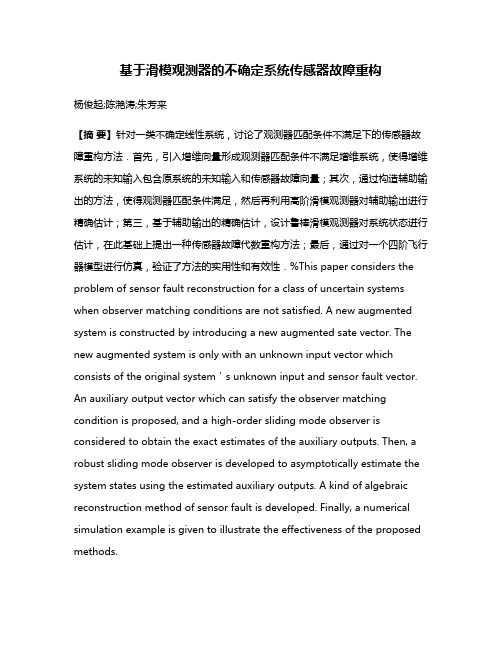
基于滑模观测器的不确定系统传感器故障重构杨俊起;陈滟涛;朱芳来【摘要】针对一类不确定线性系统,讨论了观测器匹配条件不满足下的传感器故障重构方法.首先,引入增维向量形成观测器匹配条件不满足增维系统,使得增维系统的未知输入包含原系统的未知输入和传感器故障向量;其次,通过构造辅助输出的方法,使得观测器匹配条件满足,然后再利用高阶滑模观测器对辅助输出进行精确估计;第三,基于辅助输出的精确估计,设计鲁棒滑模观测器对系统状态进行估计,在此基础上提出一种传感器故障代数重构方法;最后,通过对一个四阶飞行器模型进行仿真,验证了方法的实用性和有效性.%This paper considers the problem of sensor fault reconstruction for a class of uncertain systems when observer matching conditions are not satisfied. A new augmented system is constructed by introducing a new augmented sate vector. The new augmented system is only with an unknown input vector which consists of the original system's unknown input and sensor fault vector. An auxiliary output vector which can satisfy the observer matching condition is proposed, and a high-order sliding mode observer is considered to obtain the exact estimates of the auxiliary outputs. Then, a robust sliding mode observer is developed to asymptotically estimate the system states using the estimated auxiliary outputs. A kind of algebraic reconstruction method of sensor fault is developed. Finally, a numerical simulation example is given to illustrate the effectiveness of the proposed methods.【期刊名称】《河南理工大学学报(自然科学版)》【年(卷),期】2012(031)004【总页数】6页(P447-452)【关键词】传感器故障重构;滑模观测器;匹配条件【作者】杨俊起;陈滟涛;朱芳来【作者单位】同济大学电子与信息工程学院,上海201804 河南理工大学电气工程与自动化学院,河南焦作454000;河南理工大学电气工程与自动化学院,河南焦作454000;同济大学电子与信息工程学院,上海201804【正文语种】中文【中图分类】TP130 引言自20世纪90年代以来,控制系统故障检测和隔离(Fault Detection and Isolation,FDI)不但成为国内外学者研究的热门课题,而且还提出了多种基于模型的FDI方法.其中,基于观测器的FDI方法得到了广泛关注.该方法包括基于滑模观测器的FDI[1-3]、基于自适应观测器的FDI[4-5]以及基于H∞观测器的FDI[6-7]等,其基本思想是通过观测器产生残差,以标识是否有故障发生,然后进行故障隔离.然而,故障检测并不能确定故障信号波形,但故障重构在检测故障的同时,却能够告诉故障信号的大小等信息,因而,故障重构具有重大意义.本文针对具有传感器故障的不确定系统,通过设计未知输入观测器(Unknown Input Observer,UIO)达到对状态估计的目的,并在状态估计的基础上提出传感器故障重构方法.正如文献[8]所述,UIO设计的充要条件是系统所有的不变零点在左半开复平面内且所谓的观测器匹配条件满足.然而,对于大多数物理系统而言,观测器匹配条件是一个很强的匹配条件.本文的创新点在于:在处理匹配条件不满足问题的同时,将该问题和传感器故障重构问题有机地结合了起来.1 模型描述考虑具有未知输入和传感器故障的不确定线性系统为,(1)式中:x∈,y∈和u∈分别为状态向量、可测输出和已知输入向量;η(t)∈k为未知输入向量;fs(t)∈q为传感器故障向量;A,B,D,C和F为相应维已知常量矩阵.假设rank F=q,rank C=p,rank D=k和n≥p≥q+k.假设1 对于系统(1),所有具有Re(s)≥0的复数s,下式成立.(2)假设2 系统状态x(t)、未知输入η(t)和传感器故障fs(t)以及它们的微分范数有界.引入状态向量z∈p,且满足下述微分方程,(3)式中:Ad∈p×p为非奇异Hurwitz矩阵.设增维向量,那么原系统(1)被扩充为如下增维系统,即,(4)式中:和.φ由原系统的未知输入向量η和传感器故障向量fs组成,并被看作增维系统(4)的未知输入.根据假设2可知,存在正常量ρ,使得‖φ‖≤ρ.(5)引理1 系统(4)是最小相位的,即,,的所有不变零点在左半开复平面内,或对所有具有Re(s)≥0的复数s,有(6)成立,当且仅当对所有个有Re(s)≥0的复数s,式(2)成立.证明基于式(2),可以得到成立.由于Ad是非奇异的,所以对所有具有Re(s)≥0的复数s,式 (2)成立,当且仅当成立.又因为,由此可以推断,对所有具有Re(s)≥0的复数s,式(2)成立,当且仅当成立.引理1得证.对于增维系统(4),由于和,故观测器匹配条件(7)不成立即.(7)不成立.对于增维系统(4),在(6)和观测器匹配条件(7)满足时,一些UIO已经被提出了[1-3,5-7,10].然而,已经证明,对于增维系统(4),观测器匹配条件(7)不成立.以下通过构造辅助输出向量使得匹配条件满足,接着设计鲁棒滑模观测器估计系统状态,以达到传感器故障重构的目的.2 基于鲁棒滑模观测器的状态估计基于相对阶概念,首先构造一个可以满足观测器匹配条件(7)的辅助输出向量.在假定辅助输出向量已知的情况下,设计一种可以对增维系统(4)进行渐近状态估计的鲁棒滑模观测器.2.1 辅助输出的构造定义1 假定ri(i=1,2,3,…,p)是满足下述方程的最小整数则系统(4)具相对于未知输入φ有向量相对阶(r1,r2,…,rp).其中,向量∈1×(n+p)是的第i个行向量.假设3 假定存在整数γi(1≤γi≤ri,i=1,2,…,p),使得……是满秩矩阵且观测器匹配条件成立.其中,…(i=1,2,…,p),γ=γ1+γ2+…+γp 称为总相对阶.引理 2[9] 系统,,和,,具有相同的不变零点.引理3[10] 引理1和观测器匹配条件(8)成立,当且仅当对于给定的对称正定矩阵∈(n+p)×(n+p),存在矩阵∈(n+p)×γ,∈(k+q)×γ和对称正定矩阵∈(n+p)(n+p),使得下述方程成立.2.2 基于辅助输出的鲁棒滑模观测器设计考虑如下与增维系统(4)具有相同状态,但具有辅助输出的辅助输出系统,(10)式中:∈γ×(n+p)由假设3给出;za为辅助输出向量.构造如下鲁棒滑模观测器α(za,,t),(11)由系统(10)减去式(11)可得观测器误差方程为α(za,,t),(12)式中:滑模控制律为α(za,,t)=ρ.(13)定理1 由式(11)和(13)确定系统(10)的鲁棒滑模观测器,即状态估计渐近收敛到真实状态.证明考虑Lyapunov函数,则V沿着误差方程(12)的微分为α(za,,t)=α(za,,t),由式(5)、(9)和滑模控制律(13)可得α≤≤≤2ρ.α(za,,t)=2ρ2ρρ,将上述方程代入表达式且根据的正定性可得≤<0.基于Lyapunov稳定性理论可知,误差方程(12)是渐近稳定的,即.因而,式(11)和(13)确定系统(10)的状态观测器.定理1得证.2.3 辅助输出及其微分的估计在定理中,辅助输出za被假定是可测的.然而,实际的输出是y或z而不是za.za不仅包含了z,还有其他未知变量.这里,采用高阶滑模观测器在有限时间内对辅助输出za进行精确估计.设,,…,,,zai,2…,zai,γi]T.微分zai可以得到.(14)引入新变量,,且把zi1=zi作为输出方程,可以得到,(15)根据假设2可知,是未知但范数有.有系统(15),考虑如下的高阶滑模观测器[11],(16)·sign(wi,j-1);κai,j>0,(j=1,2,…,γi+1).定理2 在假设2成立的情况下,高阶滑模观测器(16)能够在有限时间内对辅助输出向量zai进行精确估计,即在有限时间内ξai=[ξai,1 ξai,2 … ξai,γi]T是zai=[zai,1 zai,2 … zai,γi]T的精确估计.证明式(15)和(16)之间的误差动态系统为,式中:eai,j=ξai,j-zai,j(j=1,2,…,γi+1).通过与文献[11]相似的方法,选择增益κai,j,可以在有限时间内到达滑模面eai,1=…=eai,γiI1.ξai,j是zai,j(j=1,2,…,γi+1)的精确估计.定理2得证.由于在有限时间内ξ …是辅助输出向量za的精确估计.基于定理1,可得如下定理.定理3 由式(17)和(18)确定系统 (10)的鲁棒滑模观测器,即状态估计渐近收敛到真实状态.ξα(ξa,,t),(17)α(ξa,,t)=ρ,(18)在得到的估计之后,由于,可得系统(1)的状态估计为.由于状态估计向量在有限时间内趋近于,那么输出误差ξ将渐进趋近于0.也就是说,控制律α(ξa,,t)将会无限大.实际上,通常采用如下关系式计算α而不是式(18).,其中,ε是一个充分小的正常量.因此,状态误差被限制在一个很小的邻域内.2.4 传感器故障重构本节基于上述状态和辅助输出微分的估计,给出了一种传感器故障重构方法.定理 4 在假设1~3成立的情况下,,(19)是原系统传感器故障fs的渐近估计.其中,由具有滑模控制律(18)的鲁棒滑模观测器(17)给出.由假设知,F是列满秩矩阵.所以,FTF可逆.定理4的证明可直接由系统(1)的输出方程得到.2.5 仿真以下用飞机侧向动力学模型[12]说明上述方法的实用性.假设某型飞机在高度为5 000 m,马赫数为0.5,初速度为160 m/s,则其如式(1)的侧向线性参考模型,其中各矩阵为,,,,,其中状态变量x1~x4分别为侧滑角变化量、滚转角速率变化量、滚转角变化量和偏航角速率变化量.输入u1和u2分别为差动副翼和方向舵控制输入.故障fs=[0.75cos (3t+4.5) 2sin 2t]T,未知输入η=2.5sin 4t.选择Ad=-10I3,那么根据式(1)和(3)可得增维系统(4)系数矩阵,,和.不难证明,观测器匹配条件是不满足的.根据定义1可知,增维系统(4)有向量相对阶(r1,r2,r3)=(2,1,1).假如选择γ1=r1=2,γ2=r2=1 和γ3=r3=1,则根据假设3可知,容易验证观测器匹配条件是成立的.由的组成可知,辅助输出有一个未知变量za1,2需要用高阶滑模观测器(16)进行精确估计(其估计效果见图1).由图1可以看出,估计效果是好的.如文献[10]所述,利用Matlab中的LMI工具箱可求得满足式(9)的,,和.基于辅助输出的精确估计,利用定理3中的鲁棒滑模观测器和定理4,可分别得到系统的状态估计和传感器故障重构.在仿真中,选ρ=20,图2和3分别给出了状态估计误差图和传感器故障重构曲线.由图2可看出,一旦由式(17)和(18)形成的鲁棒滑模观测器到达滑模面,即可实现状态估计,从而实现传感器故障重构(图3),而且状态估计和传感器重构效果是令人满意的.3 结语在观测器匹配条件不满足情况下,一类不确定线性系统的传感器故障重构方法.首先,引入增维向量,使得含有传感器故障的系统扩充为只含有未知输入的增维系统,通过构造辅助输出突破观测器匹配条件限制并利用高阶滑模观测器对辅助输出进行精确估计.其次,设计鲁棒滑模观测器对系统状态进行估计.仿真实例的结果验证了该方法的可行性.参考文献:[1] EDWARDS C, SPURGEON S K, PATTON R J. Sliding mode observers for fault detection and isolation[J]. Automatica, 2000, 36(4): 541-553.[2] TAN C P, EDWARDS C. Sliding mode observers for robust detection and reconstruction of actuator faults[J]. International Journal of Robust Nonlinear and Control, 2003, 13(5): 443-446.[3] 赵瑾,顾幸生,申忠宇.不确定动态系统的执行器故障检测与重构[J].控制与决策,2007,22(5):510-514.[4] XU A, ZHANG Q. Nonlinear system fault diagnosis based on adaptive estimation[J]. Automatica, 2004, 40(7): 1181-1193.[5] JIANG B, FAHMIDA N C. Parameter fault detection and estimation ofa class of nonlinear systems using observers[J]. Journal of The Franklin Institure, 2005, 342(7): 725-736.[6] 赵瑾,申忠宇.滑模观测器实现不确定系统的鲁棒故障重构[J].东南大学学报:自然科学版,2011,41(S):36-42.[7] PERTEW A M, MARQUEZ H J, ZHAO Q. LMI-based sensor fault diagnosis for nonlinear Lipschitz systems[J]. Automatica, 2007, 43(8): 1464-1469.[8] KALSI K, LIAN J, HUI S, et al. Sliding-mode observers for systems with unknown inputs: A high-gain approach[J]. Automatica, 2010,46(2): 347-353.[9] FLOQUET T, EDWARDS C, SPURGEON S.K. On sliding mode observers for systems with unknown inputs[J]. International Journal of Adaptive Control and Signal Processing, 2007, 21(8/9): 638-656.[10] CORLESS M, TU J. State and input estimation for a class of uncertain systems[J]. Automatica, 1998, 34(6): 757-764.[11] LEVANT A. Higher-order sliding modes, differentiation and output-feedback control[J]. International Journal of Control, 2003, 76(9-10): 924-941.[12] 杨伟,章为国,杨朝旭,等.容错飞行控制系统[M].西安:西北工业大学出版社,2007.。
基于键合图的鲁棒故障诊断及容错控制
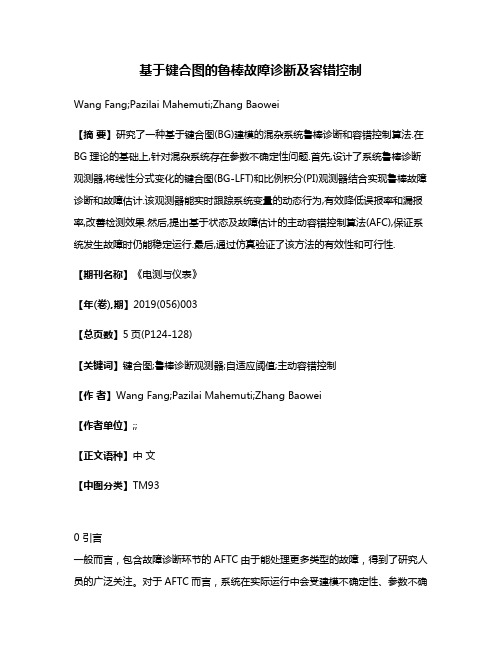
基于键合图的鲁棒故障诊断及容错控制Wang Fang;Pazilai Mahemuti;Zhang Baowei【摘要】研究了一种基于键合图(BG)建模的混杂系统鲁棒诊断和容错控制算法.在BG理论的基础上,针对混杂系统存在参数不确定性问题.首先,设计了系统鲁棒诊断观测器,将线性分式变化的键合图(BG-LFT)和比例积分(PI)观测器结合实现鲁棒故障诊断和故障估计.该观测器能实时跟踪系统变量的动态行为,有效降低误报率和漏报率,改善检测效果.然后,提出基于状态及故障估计的主动容错控制算法(AFC),保证系统发生故障时仍能稳定运行.最后,通过仿真验证了该方法的有效性和可行性.【期刊名称】《电测与仪表》【年(卷),期】2019(056)003【总页数】5页(P124-128)【关键词】键合图;鲁棒诊断观测器;自适应阈值;主动容错控制【作者】Wang Fang;Pazilai Mahemuti;Zhang Baowei【作者单位】;;【正文语种】中文【中图分类】TM930 引言一般而言,包含故障诊断环节的AFTC由于能处理更多类型的故障,得到了研究人员的广泛关注。
对于AFTC而言,系统在实际运行中会受建模不确定性、参数不确定性及未知干扰等影响,在应用中应注意以下两点:一、基本控制器应具有鲁棒性,在控制率重构期间使系统保持稳定;二、故障诊断单元应具备鲁棒性,进而减少误报率与漏报率[1]。
近年来,国内外鲁棒故障重构研究也取得了一系列成果,文献[2]研究了在离散事件触发机制条件下,网络化控制系统的主被动混合鲁棒H_&容错控制设计方法。
文献[3]针对四旋翼飞行器在飞行过程中存在执行机构故障和各种不确定因素的控制问题,提出了一种将时延控制技术与滑模控制技术相结合的鲁棒容错控制方法。
文献[4]针对一类发生执行器故障的非线性系统,提出基于线性矩阵不等式(LMI)的一体化鲁棒主动容错控制器设计方法。
文献[5]提出了一种主动模糊容错控制的感应电机策略,以确保场控制的性能。
故障检测诊断技术综述

故障检测与诊断技术综述【摘要】本文对故障检测与诊断技术进行了综述,主要介绍了故障诊断的重要性及经济效益,介绍了故障诊断的基本分析方法,结合学科交叉融合性,介绍了多学科相结合的故障诊断分析方法。
【关键词】故障检测;故障诊断;小波分析一、概述现代化工业技术发展突飞猛进,现代工业自动化程度越来越高,系统规模也越来越大,简单控制系统已经不能达到工业生成的需求,大规模、综合性、复杂的自动化系统运用越来越广[1]。
自动化设备和系统结构的日益复杂和集成化,使得系统发生故障的机率也增加,故障的产生会毁坏设备,影响系统正常运转,甚至造成人员伤亡。
国内外由于设备故障所引起的设备损坏、锅炉爆炸、道路塌陷,不仅造成经济损失也造成人员伤亡,社会影响及其恶劣。
为了达到以人为本同时维护经济的目的,可以加强系统的稳定性、可靠性、鲁棒性和安全性,但任何设备都不可能无限期使用,这就需要防患于未然,因此故障检测技术应运而生。
二、故障检测重要性故障检测技术是是一门多学科融合交叉性学科[1],如:信号提取则依赖于传感器及检测技术;信号降噪离不开信号处理技术;状态估计和参数估计方法以系统辨识理论为基础;鲁棒故障诊断涉及到鲁棒控制理论知识;此外数值分析、概率与数理统计等基础学科也是故障检查和诊断不可缺少的方法。
多门学科知识的支撑确保了故障诊断技术的迅速发展,在工业领域也应用广泛,如化工生产、冶金工业、电力系统、航空航天、机器人等生产的各个领域。
三、故障检测技术经济效益数据显示[2],故障检测技术与经济发展息息相关,对故障检测技术的研究与发展越来越多,在工业生产中也得到了应用和推广。
通过故障诊断技术的推广,大大降低了设备维修费用,各国在故障诊断技术上的投入也逐渐增加。
日本对故障检测与诊断技术的投入占其生产成本的5.6%,德国和美国所占比例分别为 9.4%和7.2%。
在冶金工业生产中,我国每年承担的设备维修的费用就高达 250 亿元,金额庞大,然而如果应用故障检测与诊断技术,每年可以减少事故发生率同时也能节约 10%~30%的维修费用。
关于医疗事故的英文

Importance of Addressing Medical Malpractice
Understaffing or Overwork
Independent staffing levels or exceptional workloads can lead to fatigue and errors
Inadequate Policies or Procedures
Healthcare organizations may lay clear guidelines or protocols for handling certificate situations
Poor Coordination of Care
Fragmented care delivery systems can lead to gaps in treatment and communication breakdowns
Insufficient Resources
Limited access to necessary equipment, medicines, or other resources can reduce patient care
Financial Burden
Medical expenses, loss waters, and the cost of onging care can create a significant financial burden for patients and their families
间隙度量模式下的闭环系统故障诊断实现
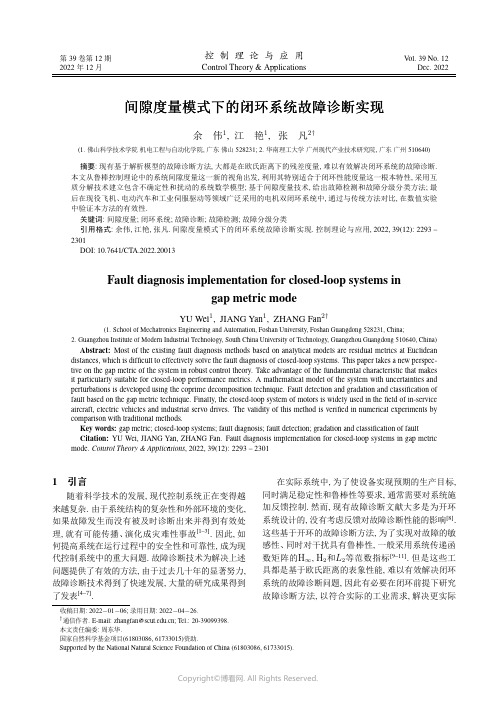
第39卷第12期2022年12月控制理论与应用Control Theory&ApplicationsV ol.39No.12Dec.2022间隙度量模式下的闭环系统故障诊断实现余伟1,江艳1,张凡2†(1.佛山科学技术学院机电工程与自动化学院,广东佛山528231;2.华南理工大学广州现代产业技术研究院,广东广州510640)摘要:现有基于解析模型的故障诊断方法,大都是在欧氏距离下的残差度量,难以有效解决闭环系统的故障诊断.本文从鲁棒控制理论中的系统间隙度量这一新的视角出发,利用其特别适合于闭环性能度量这一根本特性,采用互质分解技术建立包含不确定性和扰动的系统数学模型;基于间隙度量技术,给出故障检测和故障分级分类方法;最后在现役飞机、电动汽车和工业伺服驱动等领域广泛采用的电机双闭环系统中,通过与传统方法对比,在数值实验中验证本方法的有效性.关键词:间隙度量;闭环系统;故障诊断;故障检测;故障分级分类引用格式:余伟,江艳,张凡.间隙度量模式下的闭环系统故障诊断实现.控制理论与应用,2022,39(12):2293–2301DOI:10.7641/CTA.2022.20013Fault diagnosis implementation for closed-loop systems ingap metric modeYU Wei1,JIANG Yan1,ZHANG Fan2†(1.School of Mechatronics Engineering and Automation,Foshan University,Foshan Guangdong528231,China;2.Guangzhou Institute of Modern Industrial Technology,South China University of Technology,Guangzhou Guangdong510640,China)Abstract:Most of the existing fault diagnosis methods based on analytical models are residual metrics at Euclidean distances,which is difficult to effectively solve the fault diagnosis of closed-loop systems.This paper takes a new perspec-tive on the gap metric of the system in robust control theory.Take advantage of the fundamental characteristic that makes it particularly suitable for closed-loop performance metrics.A mathematical model of the system with uncertainties and perturbations is developed using the coprime decomposition technique.Fault detection and gradation and classification of fault based on the gap metric technique.Finally,the closed-loop system of motors is widely used in thefield of in-service aircraft,electric vehicles and industrial servo drives.The validity of this method is verified in numerical experiments by comparison with traditional methods.Key words:gap metric;closed-loop systems;fault diagnosis;fault detection;gradation and classification of fault Citation:YU Wei,JIANG Yan,ZHANG Fan.Fault diagnosis implementation for closed-loop systems in gap metric mode.Control Theory&Applications,2022,39(12):2293–23011引言随着科学技术的发展,现代控制系统正在变得越来越复杂.由于系统结构的复杂性和外部环境的变化,如果故障发生而没有被及时诊断出来并得到有效处理,就有可能传播、演化成灾难性事故[1–3].因此,如何提高系统在运行过程中的安全性和可靠性,成为现代控制系统中的重大问题.故障诊断技术为解决上述问题提供了有效的方法,由于过去几十年的显著努力,故障诊断技术得到了快速发展,大量的研究成果得到了发表[4–7].在实际系统中,为了使设备实现预期的生产目标,同时满足稳定性和鲁棒性等要求,通常需要对系统施加反馈控制.然而,现有故障诊断文献大多是为开环系统设计的,没有考虑反馈对故障诊断性能的影响[8].这些基于开环的故障诊断方法,为了实现对故障的敏感性、同时对干扰具有鲁棒性,一般采用系统传递函数矩阵的H∞,H2和L2等范数指标[9–11].但是这些工具都是基于欧氏距离的表象性能,难以有效解决闭环系统的故障诊断问题,因此有必要在闭环前提下研究故障诊断方法,以符合实际的工业需求,解决更实际收稿日期:2022−01−06;录用日期:2022−04−26.†通信作者.E-mail:*****************.cn;Tel.:20-39099398.本文责任编委:周东华.国家自然科学基金项目(61803086,61733015)资助.Supported by the National Natural Science Foundation of China(61803086,61733015).2294控制理论与应用第39卷的生产安全性问题[12].目前基于闭环系统的故障诊断已有部分成果,文献[13]验证了转矩功率谱在开环系统下可以用来检测感应电动机的电气故障,但在闭环情况下用于开环操作的指标不再有效.文献[14]通过设计一个常规观测器和一个不受敏感器故障累积效应影响的特殊观测器结合,对无刷直流电机的典型输入和输出性故障型故障准确定位和隔离,但在使用这种方法时需要观测器与模型完全匹配,因此这种方法有很大的局限性.文献[15]通过设计增广系统观测器的方法对高速列车牵引电机闭环系统的传感器故障进行分析,这种方法可以减少故障在闭环系统内传播的影响,但对于控制效果、干扰对输出的鲁棒性和故障对于残差的可检测性不能兼顾,无法获得全局的解决方法,对于微小故障达不到相应的检测要求.由于发生故障的系统与正常系统间几乎必然出现一定程度差异,因此,可以使用一种所谓间隙(gap)度量方法从系统角度来判别闭环系统之间的差异.早期gap度量技术广泛应用于鲁棒控制理论中的不确定闭环稳定性分析[16–18],经过近几年的发展,基于gap度量的方法逐渐被应用于故障诊断的研究领域中.文献[19]指出传统系统差异的度量可能无法准确预测闭环系统性能的变化,因此提出一种基于gap度量的方法可以作为对故障系统进行诊断的一种新途径.文献[20]和文献[21]采用v-gap度量对系统的故障严重程度进行分级分类研究,文献[22–24]提出将gap度量技术辅助故障检测与隔离的分析方法,目前这些方法还处于理论探索阶段.受上述文献启发,本文针对包含不确定性和扰动的闭环系统,从系统整体角度出发,在间隙度量模式下,进行故障检测和分级分类,通过故障系统与正常系统的k-gap度量值为指标,将故障对系统的危害程度划分为多个界限清晰的故障等级,并依据同一级别故障系统之间的k-gap度量值,进一步对故障进行分类,最后通过数值仿真,对电机双闭环系统,验证本方法的有效性.注1本文所采用的符号表示如下:RH∞(RH m×n∞)表示稳定系统的所有(m×n维)实有理传递函数的集合;H2表示所有信号的子空间,这些信号的能量是有界的,且K<0时为零;H∞表示稳定的所有传递函数的集合;sup表示上确界;inf表示下确界;I m×m(I p×p)表示m×m(p×p)维单位阵.2预备知识在本节中,首先简要介绍互质分解技术,在此基础上,引入gap度量,k-gap度量以及基于互质分解技术的故障模型一般形式相关基础知识.2.1互质分解技术2.1.1左互质分解和稳定核表示给定¯M∈RH m×m∞,¯N∈RH m×p∞,如果存在¯X∈RH m×m∞,¯Y∈RH p×m∞,使得[¯M¯N][¯X¯Y]=I m×m,(1)则称它们为在RH∞上的左互质.考虑一个线性时不变系统y=Gu,(2)则G的一个左互质分解可写成G=¯M−1¯N.(3)由式(3)可知,系统模型式(2)可改写成[¯M−¯N][yu]=0.(4)对于一个线性时不变系统,如果S[yu]=0,并且它是稳定的,则称S,y和u是系统(2)的稳定核表示,其中[¯M−¯N][yu]是系统(2)的一个稳定核表示.2.1.2右互质分解和稳定像表示类似于左互质的概念,给定M∈RH p×p∞,N∈RH m×p∞,如果存在X∈RH p×p∞,Y∈RH p×m∞,使得[X Y][MN]=I P×P,(5)则称它们为在RH∞的右互质.一个传递函数矩阵G对应的右互质分解可以写成G=NM−1.更进一步系统模型可以等效表示为y=Gu=NM−1u,(6)由式(6),稳定像表示可以被描述为[uy]=[MN]v,(7)其中v表示参考输入.2.2gap度量技术2.2.1图和gap度量通过式(7)可以得到对于v∈H2,所有输入输出对(u,y)在H2中建立一个子空间并且它是闭合的.这个子空间被称为系统(6)的图,并且可以表示为ϑ={z=[uy]=[MN]v,v∈H2}.(8)第12期余伟等:间隙度量模式下的闭环系统故障诊断实现2295由式(8)可以得到图表示的一般形式ϑi :{z i =[u i y i ]=[M iN i]v,v ∈H 2},i =1,2.(9)一般而言,间隙是指希尔伯特空间中两个封闭子空间之间距离的度量.令ϑ1,ϑ2是两个图,从ϑ1到ϑ2的有向间隙,通过⃗δ(ϑ1,ϑ2)表示,被定义为⃗δ(ϑ1,ϑ2)=sup z 1∈ϑ1infz 2∈ϑ2∥z 1−z 2∥2∥z 2∥2.(10)由式(10)可知⃗0 ⃗δ(ϑ1,ϑ2) ⃗1.令G 1=N 1M −11,G 2=N 2M −12分别表示ϑ1,ϑ2的归一化右互质分解.有向间隙⃗δ(ϑ1,ϑ2)可以通过解决下面的模型匹配问题来计算:⃗δ(ϑ1,ϑ2)=inf Q ∈H ∞∥[M 1N 1]−[M 2N 2]Q ∥∞.(11)ϑ1和ϑ2之间的gap 度量被定义为δ(ϑ1,ϑ2)=max {⃗δ(ϑ1,ϑ2),⃗δ(ϑ2,ϑ1)}.(12)若⃗δ(ϑ1,ϑ2)<1,则δ(ϑ1,ϑ2)=⃗δ(ϑ2,ϑ1)=⃗δ(ϑ1,ϑ2).(13)2.2.2k -gap 度量间隙度量是在像子空间中定义的,它被广泛用于反馈控制系统的稳定性分析.对于故障检测性能的分析,核子空间中的度量是至关重要的,因此,引入k -gap 度量作为两个核子空间之间的距离测量.为此,引入下面的图定义κ={z =[−¯N(z )¯M (z )][u y ]=0,[u y]∈H 2}.(14)类似于gap 度量的图定义,式(14)表示所有输入输出对(u,y )在H 2中建立一个封闭的核子空间,它的图表示可以被一个传递函数矩阵G 的任意稳定核表示定义.为了测量两个不同图κ1和κ2之间的距离,根据有向间隙定义(10),可以引入以下k -gap 度量的定义.定义1使¯M−1i(s )¯N i (s )是G i 的一个左互质分解,i =1,2且满足κi ={z i =[−¯Ni (s )¯M i (s )][u i y i ]=0,[u i y i]∈H 2},则有向k -gap 可以表示为⃗δκ(κ1,κ2)=sup ¯z 1∈κ1inf ¯z2∈κ2∥¯z 1−¯z 2∥2∥¯z 1∥2.(15)类似于式(12)中给出的gap 度量定义,可以引入k -gap 度量的定义为δκ(κ1,κ2)=max {⃗δκ(κ1,κ2),⃗δκ(κ2,κ1)}.(16)一般说来,k -gap 度量是对H 2中两个内核子空间之间距离的度量,这两个内核子空间分别由来自两个不同过程的输入和输出信号.此外,与gap 度量不同的是,k -gap 度量目前主要用来量化标称系统到不确定系统或故障系统的距离,因此,k -gap 度量被更多用于故障诊断内容中.接下来,给出上面引入的k -gap 度量的计算方案.定理1给定κi ,i =1,2,如定义1中所定义,其中¯M i ,¯N i 作为系统G i 的归一化左互质分解,则下式成立:⃗δκ(κ1,κ2)=inf Q ∈H ∞∥[−¯N1¯M 1]−Q [−¯N 2¯M 2]∥∞,(17)其中:κ1=[−¯N 1¯M 1],κ2=[−¯N 2¯M 2],Q ∈H ∞是参数矩阵.推论1设¯M 1,¯N 1为G 1的归一化左互质分解,M 2,N 2为G 2的归一化右互质分解,则有⃗δκ(κ1,κ2) ¯M 1N 2−¯N 1M 2∞.(18)式(18)给出了k -gap 度量的近似计算.2.3基于互质分解技术的系统建模在本节中,介绍基于互质分解技术建立无故障模型,在此基础上,推导出带有不确定性和扰动的故障模型一般形式.2.3.1无故障模型假设标称系统(无故障和不确定性)模型描述为y =G 0u =¯M −10¯N 0u,(19)其中:y ∈R m ,u ∈R p ,为了描述模型的不确定性和各种干扰,标称模型(19)可以扩展为y =(¯M 0+∆¯M 0)−1[¯N 0+∆¯N 0¯N d +∆¯N d ][u d],(20)其中:∆¯M 0,∆¯N 0,∆¯N d ∈H ∞表示模型不确定性,称为互质因子不确定性;d 和¯N d ∈RH m ×n ∞表示(有界的)未知输入向量(干扰).2.3.2故障模型的一般形式加性故障:考虑标称模型(19),通过在式(19)中引入一项¯Nf f 表示加性故障模型如下所示:y =¯M −10[¯N 0¯N f ][u f ].(21)乘性故障:类似于处理模型不确定性的方式,将标称模型(19)扩展为y =(¯M 0+¯M f )−1(¯N 0+¯N f )u,(22)其中¯Mf ,¯N f ∈RH ∞用来表示乘性故障,也称为参数2296控制理论与应用第39卷故障.当同时考虑系统的不确定性、扰动、加性故障和乘性故障时,互质分解技术建立系统模型的一般形式可以描述为y =(¯M 0+¯M f +∆¯M 0)×[¯N 0+¯N f +∆¯N 0¯N f 1+∆¯N f 1¯N d +∆¯N d ] u f 1d ,(23)其中:∆¯M 0,∆¯N 0,∆¯N f 1,∆¯N d ∈H ∞表示模型不确定性,d 和¯N d ∈RH m ×n ∞表示系统扰动,¯N f 1和f 1表示加性故障,¯Mf ,¯N f ∈RH ∞表示乘性故障.3基于k -gap 度量的闭环系统故障诊断方法在本节中,介绍基于互质分解技术的残差生成器和阈值设置方法,并依据k -gap 度量值定义故障诊断指标.3.1残差生成器与阈值设置3.1.1残差生成器对于标称系统(19),给出稳定核表示的一般形式r 0=[¯M 0−¯N 0][y u].(24)对于所有的线性时不变系统,一种参数化的残差生成器可以表示为r =Rr 0=R [¯M 0−¯N 0][y u ],(25)其中R ∈RH ∞是参数矩阵.在故障诊断研究中,残差生成器式(24)的动态变化,在模型不确定性、系统扰动和待检测故障方面起着重要作用.假设系统动态过程由式(23)描述,则可直接得到r 0=[¯M0−¯N 0][y u]=[¯N f +∆¯N 0¯N f 1+∆¯N f 1¯Nd +∆¯N d ] u f 1d−(¯M f +∆¯M 0)y.(26)反馈控制回路是故障诊断中应用领域之一,考虑如图1所示的反馈控制回路.它可以表示为[u y ]=[(I −KG )−1K (I −GK )−1G (I −KG )−1(I −GK )−1][v d ].(27)控制器:u =Ky +v.(28)输出:y =Gu +d.(29)图1反馈控制回路Fig.1Feedback control loops反馈控制回路中:v 是控制回路的参考信号,d 表示扰动向量,K 是反馈控制律,G 表示具有互质因子不确定性的对象模型.假设系统中存在乘性故障,将残差生成器式(24)运用到反馈控制式(27),可得式(30).r 0=[∆¯N 0+¯N f −¯M f −∆¯M 0][u y]+(¯N d +∆¯N d )d =[∆¯N 0−∆¯M 0][(I −KG )−1K (I −GK )−1G (I −KG )−1(I −GK )−1][vd ]+[¯N f −¯M f ][(I −KG )−1K (I −GK )−1G (I −KG )−1(I −GK )−1][vd]+(¯N d +∆¯N d )d.(30)3.1.2阈值设置在后续研究中,用L 2范数评估残差信号r 0.假设∥∆¯N 0∆¯M 0∥∞ δ∆,∥∆¯Nd ∥∞ δ∆d ,(31)其中:δ∆表示系统不确定性,δ∆d 表示扰动不确定性,δ∆,δ∆d ∈(0,1).从残差生成器式(30)可知,闭环系统阈值为J th =sup∥∆¯N 0∆ˆM 0∥∞ δ∆∥∆¯N d∥∞ δ∆d∥r 0∥2=sup∥∆¯N 0∆¯M 0∥∞ δ∆∥∆¯N d∥∞ δ∆d∥[∆¯N 0−∆¯M 0]J (K,G )[vd]+(¯N d +∆¯N d )∥2,(32)其中J (K,G )=[(I −KG )−1K (I −GK )−1G (I −KG )−1(I −GK )−1].参考信号v 一般都是在线设置或计算的,并且J (K,G )取决于模型的不确定性,给出闭环系统的阈值设置公式如下:J th :=δ∆∥J (K,G )∥∞√∥v ∥22+∥d ∥22+¯δd ∥d ∥2,(33)第12期余伟等:间隙度量模式下的闭环系统故障诊断实现2297其中:¯δd =δ∆d +∥d ∥∞,∥J (K,G )∥∞将控制器设计和阈值设置联系起来.在鲁棒控制理论中,b G,K =∥J (K,G )∥−1∞称为稳定裕度,取值范围在[0,1]内.3.2故障检测指标定义2给定标称模型y =¯M −10¯N 0u 和故障模型y =¯M −1¯Nu ,它们的归一化左互质对分别为(¯M 0,¯N0)和(¯M,¯N ),k -gap 度量δK (K 0,K f )为δK (K 0,K f )=inf Q ∈H ∞∥[¯M0−¯N 0]−Q [¯M −¯N ]∥∞,(34)其中:K 0=[¯M0−¯N 0],K f =[¯M −¯N ],Q ∈H ∞,式(34)表示故障可检测指标.回顾上节中k -gap 度量的含义,δK (K 0,K f )实际上是对于无故障系统和故障系统之间运行状况核子空间的度量.由式(34),可以得到∀Q ∈H ∞,r 0=[¯M0−¯N 0][y u]=([¯M0−¯N 0]−Q [¯M −¯N ])[y u].(35)令Q ∗=arg inf Q ∈H ∞∥[¯M0−¯N 0]−Q [¯M −¯N ]∥∞,它可以转换成∥r 0∥2=∥([¯M0−¯N 0]−Q ∗[¯M −¯N ])[y u ]∥2 ∥([¯M0−¯N 0]−Q ∗[¯M −¯N ])∥∞∥[y u]∥2=δK (K 0,K f )√∥u ∥22+∥y ∥22.(36)显然,由式(36)可知,一个更大的δK (K 0,K f )意味着更强的故障可检测性.在考虑系统的不确定性和扰动时,通过阈值设置式(33),可以给出以下基于k -gap 度量的故障检测逻辑:∥r 0∥2 J th 故障未发生;∥r 0∥2>J th 故障发生.3.3故障分级分类指标如果系统发生的故障对系统的危害性很小,就可以认为是小等级的故障,否则就可以认为是其他等级的故障[25–27].按照故障的危害程度进行分级,可以为后续系统容错控制提供重要依据.为实现对闭环系统故障进行分级分类,可以采用k -gap 度量值作为故障分级分类指标.故障对系统性能的危害程度可以依据k -gap 度量值的大小来划分系统故障严重等级,故障分级图如图2所示.小故障等级:0<δK (K 0,K f ) ξ1;中故障等级:ξ1<δK (K 0,K f ) ξ2;大故障等级:ξ2<δK (K 0,K f ) ξ3;严重故障等级:ξ3<δK (K 0,K f )<1.图2k -gap 度量故障分级示意图Fig.2Diagram of k -gap metric fault gradation同一级别的故障其闭环特性也会有所不同,因此可以进一步将同级别故障进行分类,故障分类图如图3所示.图3k -gap 度量故障分类示意图Fig.3Diagram of k -gap metric fault classification基于上述的分级机制,每一故障等级都需要一个阈值,因此可以依据故障模型之间的k -gap 度量值设置多级阈值ςi (0<ςi <1,i =1,2,3,4),同级别故障模型之间的k -gap 度量为δ(f i ,f j )(i,j ∈N +).给出基于k -gap 度量的故障分类逻辑如下:δ(f i ,f j ) ςi 同级同类故障;δ(f i ,f j )>ςi 同级不同类故障.4仿真验证4.1电机双闭环系统转速、电流反馈控制的电机双闭环系统凭借其优良的静、动态性能在现役飞机、电动汽车和工业伺服驱动等领域被广泛应用.2298控制理论与应用第39卷根据电机统一理论,采用磁动势相等原则,多相电机可以等价为两相电机,原始坐标经过坐标变换,可变换到旋转坐标dq 轴下,采用转子磁链定向控制策略,等效为一台直流电动机[28].等效电路如图4所示.图4多相电机等效电路图Fig.4Equivalent circuit diagram for multi-phase motors电机双闭环系统的动态结构框图如图5所示,其中W 1表示转速环PI 调节器,W 2表示电流环PI 调节器,W S 表示电力电子变换装置,W Tl 表示电机的电磁环节,W Tm 表示电机的机电环节.在图5中,为了获得良好的静、动态性能,转速和电流两个调节器一般都采用PI 调节器.根据陈伯时主编的教材[29],设计电机双闭环系统各环节传递函数如表1所示,使电机双闭环系统的动态性能达到最优.表1双闭环系统各个环节传递函数Table 1Transfer functions for each link of a doubleclosed-loop system传递函数转速环PI 调节器W 1(s )=11.7s +134.48s电流环PI 调节器W 2(s )=2.027s +67.567s 电力电子变换装置W S (s )=400.0017s +1电机电磁环节W Tl (s )=20.03s +1电机机电环节W Tm (s )=0.50.18s图5电机双闭环系统动态结构框图Fig.5Block diagram of the dynamic structure of a double closed-loop motor system在实际应用中,系统的不确定性和扰动是不可避免的,带有不确定性和扰动电机双闭环系统模型可以由式(20)来表示.其中互质分解因子不确定性的H ∞范数界限应满足式(31),设定δ∆=0.01,δ∆d =0.02,负载扰动d =2,输入电压u =1V .上述设计的带有系统不确定性和扰动的电机双闭环系统(标称系统G 0)传递函数为G 0=3.8636×10−4s 4+0.2402s 3+7.1942×103s 2+3.2216×105s +2.7535×1069.18×10−6s 5+0.0057s 4+1.6411s 3+97.5112s 2+2.1456×103s +1.8388×104.4.2故障检测针对电机双闭环系统中的不同程度乘性故障和执行器故障,以F ij (i =1表示乘性故障,i =2表示执行器故障;j =1∼9,分别表示10%∼90%故障严重程度)为故障程度因子,取值范围为0.1∼0.9.分别选取机电时间常数变化和转速调节器增益变化作为乘性故障和执行器故障,具体表示为W Tm (s )=0.5(F 1j 0.18)s,W 1(s )=(F 2j 11.7)s +134.48s.整个仿真时间设为5s,在t =2s 时刻分别加入不同程度的乘性故障和执行器故障.传统故障检测方法一般采取提取故障特征量的方法来判别系统的异常情况.当电机双闭环系统分别出现不同程度乘性故障(F 11,F 13,F 16和F 18)和执行器故障(F 21,F 23,F 26和F 28)时,采集电枢电压和电枢电流作为故障特征量,采用文献[30]中的平均能量法设置阈值J th =±0.0949,故障检测结果分别如图6–7所示.由图6(a)可知,发生乘性故障后故障超过阈值时间约为0.2s,电枢电压故障残差最大幅值为0.57V;由图6(b)可知,故障超过阈值时间约为0.3s,电枢电流故障残差最大幅值为1.35A.因此在采用传统的故障检测方法时,故障出现的时间短,在检测时难以捕捉,不同故障特征量产生的残差大小不同,极易受系统量纲的影响,故障出现之后很快被双闭环系统反馈控制的作用所抑制,导致无法对故障进行有效检测.类似于乘性故障,如图7所示,在发生执行器故障后也呈现出上述特点.针对欧氏距离的表象性能,难以有效解决闭环系统的故障检测问题,采用k -gap 度量的故障检测方法在同等条件下进行仿真分析.不同程度的故障模型G F ij 与标称模型G 0之间的第12期余伟等:间隙度量模式下的闭环系统故障诊断实现2299k -gap 度量值分别如表2所示.V(a)电枢电压(b)电枢电流图6乘性故障检测图Fig.6Multiplicative fault detectiondiagram(a)电枢电压(b)电枢电流图7执行器性故障检测图Fig.7Actuator fault detection diagram表2不同程度故障模型与标称模型的k -gapTable 2k -gap for different degrees of failure modelswith nominal modelsF ijδk (G F 1j ,G 0)δk (G F 2j ,G 0)0.90.05410.05530.80.10980.11680.70.17650.18520.60.25020.26060.50.33190.35080.40.42900.45070.30.54090.56540.20.67110.69760.10.81970.8493由表2可以看出,随着故障程度的增加,故障模型与带有不确定性和扰动模型之间k -gap 度量值也不断增大.由闭环系统阈值设置式(33)可以得到阈值J th =4.4671,基于k -gap 度量的残差,对电机双闭环系统不同程度的乘性故障和执行器故障,故障检测结果分别如图8–9所示.可以看出随着故障程度的增加,故障可检测性也不断增加,k -gap 度量方法从系统的角度进行故障检测,不会受到量纲的影响,并且故障发生后不会受到双闭环系统反馈控制的影响.图8基于k -gap 度量的乘性故障检测Fig.8Multiplicative fault detection based on the k -gapmetric图9基于k -gap 度量的执行器故障检测Fig.9Actuator fault detection based on the k -gap metric2300控制理论与应用第39卷4.3故障分级分类根据表2中故障系统和标称系统间的k-gap度量值(反映了故障对系统的危害程度),由故障分级机制将电机双闭环系统划分为如下4个不同的故障严重程度等级:小故障等级:0<δk(G Fij,G0) 0.15;中故障等级:0<δk(G Fij,G0) 0.4;大故障等级:0<δk(G Fij,G0) 0.7;严重故障等级:0.7<δk(G Fij,G0)<1.依据电机双闭环系统分级结果,接下来,对同一等级故障进行分类.因在实际闭环控制系统中,理论上当两个不同等级故障发生时,容错控制会进行控制器切换,所以进行两个不同等级故障分类划分,无实际意义.因此,表3给出了故障在同一等级下,依据不同程度故障模型之间的k-gap度量值,对应上述4个故障等级(小、中、大、严重),得到各级的分类阈值为0.1, 0.3,0.5和0.7.例如,对于小故障等级,故障模型之间的k-gap小于0.1时被认为两个故障为同级同类故障,否则为同级不同类故障,其余故障等级分类机制与小故障等级相同.根据各级的分类阈值,可将电机双闭环系统,同级故障分类结果如图10所示.表3同等级故障模型之间的k-gapTable3k-gap between fault models of the same grade故障等级乘性故障的k-gap执行器故障的k-gap两种故障之间的k-gap小F11F12F21F22F21F22 F1100.0563F2100.0619F110.10920.1700 F120.05630F220.06190F120.16410.2228中F13F14F15F23F24F25F23F24F25 F1300.07870.1650F2300.08130.1761F130.35180.42160.4985 F140.078700.0878F240.081300.0963F140.41970.48520.5566 F150.16500.08780F250.17610.09630F150.48900.54930.6141大F16F17F18F26F27F28F26F27F28 F1600.14480.3355F2600.15260.3559F160.74140.80510.8722 F170.144800.2032F270.152600.2145F170.80240.85280.9050 F180.33550.20320F280.35590.21450F180.86690.90240.9383严重F19F29F29 F190F290F190.9879图10电机双闭环系统故障分类图Fig.10Motor double closed loop system fault classification diagram5结论针对闭环系统的故障诊断,现有基于解析模型的方法中,基于物理数值的偏差(残差估计)只是表象,极度依赖于每个分量的物理量纲.为克服难以刻画其内在本质变化的困难,本文从间隙度量这一新的视角出发,针对包含不确定性和扰动的电机双闭环系统,根据故障模型与标称系统模型,以及故障模型之间的k-gap度量值,得到了故障检测和故障分级分类的具体实现过程.结果表明,此方法有利于闭环系统故障检测和不同类别故障评级分类,对后续容错控制器选择提供判据,此方法也可用于风险投资相关闭环系统诊断.参考文献:[1]ZHANG K,JIANG B,SHI P.Distributed fault estimation observerdesign with adjustable parameters for a class of nonlinear intercon-nected systems.IEEE Transactions on Cybernetics,2019,49(12): 4219–4228.[2]QIU A B,GU J P,WEN C B,et al.Self-triggered fault estimationand fault tolerant control for networked control systems.Neurocom-puting,2018,272:629–637.[3]ZHONG Donghua,SHI Jiantao,HE Xiao.Review of intermittent第12期余伟等:间隙度量模式下的闭环系统故障诊断实现2301fault diagnosis techniques for dynamic systems.Acta Automatica Sinica,2014,40(2):161–171.(周东华,史建涛,何潇.动态系统间歇故障诊断技术综述.自动化学报,2014,40(2):161–171.)[4]LUO Hao,HUO Mingyi,YIN Shen,et al.Fault diagnosis and safe-ty control for complex industrial rmation and Control, 2021,50(1):20–33.(罗浩,霍明夷,尹珅,等.复杂工业系统故障诊断与安全控制方法.信息与控制,2021,50(1):20–33.)[5]DU Xianjun,GONG Bin,SHI Yaoke.Research on CBAM-CNN ba-sed analog circuit fault diagnosis.Control and Decision,2022, 37(10):2609–2618.(杜先君,巩彬,石耀科.基于CBAM-CNN的模拟电路故障诊断研究.控制与决策,2022,37(10):2609–2618.)[6]L¨U Xueyan,WANG Jing,ZHOU Jinglin.Active fault diagnosis ba-sed on auxiliary signals and redundant actuators.Control and Deci-sion,2022:DOI:10.13195/j.kzyjc.2021.0354.(吕雪燕,王晶,周靖林.基于辅助输入信号和冗余执行器的主动故障诊断.控制与决策,2022:DOI:10.13195/j.kzyjc.2021.0354.)[7]WANG Yinsong,SUN Tianshu.A method of actuator fault diagnosisbased on evidence fusion.Control and Decision,2022,37(8):2026–2032.(王印松,孙天舒.一种基于证据融合的执行器故障诊断方法.控制与决策,2022,37(8):2026–2032.)[8]CHEN T.Small fault detection for a class of closed-loop systems viadeterministic learning.IEEE Transactions on Cybernetics,2018, 49(3):897–906.[9]SUN Kai,HE Baina,SARAH Odofin,et al.Current sensor fault diag-nosis for induction motor in vector control system.Journal of System Simulation,2018,30(8):3139–3145.(孙凯,何柏娜,SARAH Odofin,等.矢量控制系统中感应电机电流传感器故障诊断.系统仿真学,2018,30(8):3139–3145.)[10]HE J,YANG Q,WANG Z.On-line fault diagnosis and fault-tolerantoperation of modular multilevel converters–A comprehensive re-view.CES Transactions on Electrical Machines and Systems,2020, 4(4):360–372.[11]ZHANG C,XU L,LI X,et al.A method of fault diagnosis for rotaryequipment based on deep learning.Prognostics and System Health Management Conference.Chongqing,CHINA:IEEE,2018.[12]ZHOU Donghua,LIU Yang,HE Xiao.Review on fault diagnosistechniques for closed-loop systems.Acta Automatica Sinica,2013, 39(11):1933–1943.(周东华,刘洋,何潇.闭环系统故障诊断技术综述.自动化学报, 2013,39(11):1933–1943.)[13]BELLINI A,FILIPPETTI F,FRANCESCHINI G,et al.Closed-loopcontrol impact on the diagnosis of induction motors faults.IEEE Transactions on Industry Applications,2000,36(5):1318–1329.[14]YANG Ping,ZAHNG Hongyue.Fault diagnosis of brushless DC mo-tor closed loopsystem based on double observers.Control Engineer-ing of China,2005,12(S1):183–190.(杨萍,张洪钺.基于双观测器的无刷电机闭环系统故障诊断.控制工程,2005,12(S1):183–190.)[15]LIU Hengbo.Reserch on fault diagnosis for traction motor in closed-loop system of high-speed railway.Nanjing:Nanjing University of Aeronautics and Astronautics,2017.(刘恒伯.高速列车牵引电机闭环系统故障诊断研究.南京:南京航空航天大学,2017.)[16]ZHOU K.Essential of Robust Control.Englewood Cliffs:DoylePrentice-Hall,1998.[17]LI X L,LIU B.Adaptive optimal robust control in gap metric.The23rd Chinese Control and Decision Conference.Mianyang,CHINA: IEEE,2011:185–190.[18]WANG S,HUANG B.Gap metric on the subgraphs of systems andthe robustness problem.IEEE Transactions on Automatic Control, 2000,45(8):1522–1526.[19]ZHOU Kemin.A new framework for fault diagnosis and fault toler-ant control.Acta Automatica Sinica,2021,47(5):1035–1042.(周克敏.故障诊断与容错控制的一个新框架.自动化学报,2021, 47(5):1035–1042.)[20]LI Ya,HOU Yandong,LIU Chang.Adaptive optimal fault-tolerantcontrol based on fault puter Engineering and Applica-tions,2021,57(23):295–302.(李雅,侯彦东,刘畅.基于故障程度的自适应优化容错控制.计算机工程与应用,2021,57(23):295–302.)[21]JIANG Y,YU W,YU W,et al.On gradation and classification offaults for permanent magnet synchronous motor systems based on v-gap metric.The10th Data Driven Control and Learning Systems Conference(DDCLS).Suzhou,China:IEEE,2021:1252–1256.[22]DING S X.Application of factorization and gap metric techniques tofault detection and isolation part II:Gap metric technique aided fDI performance analysis.IFAC Papers OnLine,2015,48(21):119–124.[23]LI L L,DING S X.Gap metric techniques and their application tofault detection performance analysis and fault isolation schemes.Au-tomatica,2020,118:109029.[24]WANG Y,HE P,ZHANG H.Fault detection for systems with modeluncertainty and disturbance via coprime factorization and gap metric.IEEE Transactions on Cybernetics,2021,52(8):7765–7775.[25]WEN Chenglin,L¨U Feiya,BAO Zhejing,et al.A review of datadriven-based incipient fault diagnosis.Acta Automatica Sinica,2016, 42(9):1285–1299.(文成林,吕菲亚,包哲静,等.基于数据驱动的微小故障诊断方法综述.自动化学报,2016,42(9):1285–1299.)[26]LIU Chun,JIANG Bin,ZHANG Ke,et al.Incipient fault detectionof linear system with disturbance.Journal of Shanghai Jiao Tong U-niversity,2015,49(6):889–896.(柳春,姜斌,张柯,等.带扰动的线性系统微小故障早期诊断方法.上海交通大学学报,2015,49(6):889–896.)[27]YU Xiaoqing,JIANG Bin,ZHANG Ke.Diagnosis of incipient sen-sor faults and application in motors.Journal of Nanjing University of Aeronautics&Astronautics,2018,50(3):321–328.(于晓庆,姜斌,张柯.传感器微小故障诊断及在电机上的应用.南京航空航天大学学报,2018,50(3):321–328.)[28]YU Wei,PI Youguo,WANG Qinruo.Fractional-order modeling forpermanent magnet synchronous motor in time and frequency domain.Control and Decision,2015,30(9):1546–1550.(余伟,皮佑国,王钦若.永磁同步电动机的分数阶时域和频域建模.控制与决策,2015,30(9):1546–1550.)[29]CHEN Boshi.Electric Power Drag Automatic Control System-Motion Control System.Beijing:China Machine Press,2003:32–40.(陈伯时.电力拖动自动控制系统―运动控制系统.北京:机械工业出版社,2003:32–40.)[30]DING S X.Advanced Methods for Fault Diagnosis and Fault-tolerantControl.Berlin:Springer,2021.作者简介:余伟博士,副教授,硕士生导师,目前研究方向为系统建模、超精密运动控制和复杂系统故障诊断研究,E-mail:****************;江艳硕士研究生,目前研究方向系统建模、故障诊断,E-mail: ************************;张凡博士,副研究员,目前研究方向为系统工程、创新管理研究,E-mail:*****************.cn.。
汽车CAN 总线系统故障检测浅析

AUTO AFTERMARKET | 汽车后市场汽车CAN总线系统故障检测浅析曹向红天津交通职业学院 天津市 300110摘 要: 本文通过研究CAN总线在汽车中的应用类型,并分析其特点,针对典型故障案例进行剖析,总结归纳常见的汽车CAN总线故障类型以及各汽车电控单元之间的数据传输,采用数据流与波形分析、故障自诊断等手段找到故障的解决办法,提出一套适用于CAN总线系统故障的处理与检测有效方案。
供汽车维修工作人员进行参考,提高工作效率,能够准确的进行故障排除。
关键词:CAN总线 波形分析 故障排除1 CAN总线在汽车中的应用汽车上电子控制单元越来越多,为减少汽车线束,同时降低整车成本,CAN总线技术应用越来越广泛。
汽车CAN总线大致有两种连接方式,一是高速CAN总线,速率可达到500kb/s。
另一种是用于车身系统的低速CAN总线,速率为100kb/s。
目前,CAN总线技术已被国内外汽车企业广泛应用。
结合信号重复率等情况,CAN 数据总线系统共有五种类型:第一类驱动CAN数据总线。
数据传输速率是500kb/s,属于典型的高速CAN总线,利用驱动系统内控制单元中的应用来建立网络。
第二类是舒适CAN数据总线。
数据传输速率是100kb/s,属于低速CAN总线,利用舒适系统控制单元中应用来建立网络。
第三类是信息娱乐CAN数据总线。
传输速率是100kb/s,属于典型的低速CAN总线,利用导航系统中应用来建立网络。
第四类是组合仪表CAN总线。
它也是低速CAN总线之一,传输速率是100kb/s。
第五类是诊断CAN总线。
它是高速CAN总线之一,传输速率是500kb/s。
2 CAN总线的组成与特点2.1 CAN总线系统的组成对于CAN数据总线来说,它主要有三个方面,一是ECU,即电控单元,二是传输介质双绞线,三是终端电阻。
1.电控单元CAN总线连接的电控单元,就是我们所说的CAN总线节点,从理论来看,这一总线能够与很多节点相连。
一种含扰动项的非线性系统执行器故障估计方法
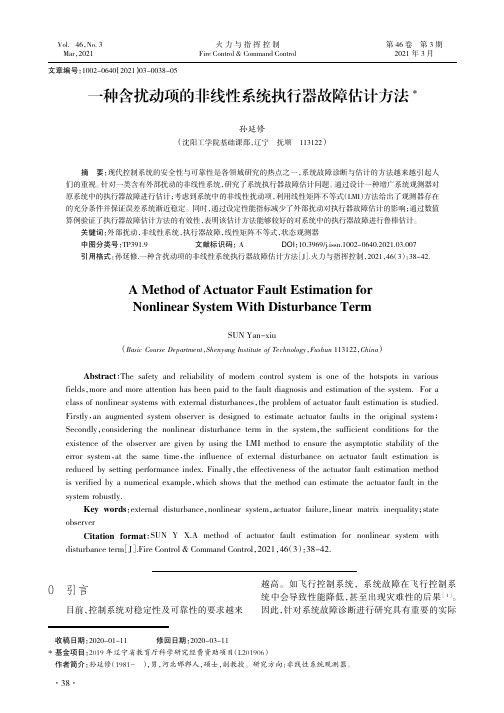
收稿日期:2020-01-11修回日期:2020-03-11基金项目:2019年辽宁省教育厅科学研究经费资助项目(L201906)作者简介:孙延修(1981-),男,河北邯郸人,硕士,副教授。
研究方向:非线性系统观测器。
*摘要:现代控制系统的安全性与可靠性是各领域研究的热点之一,系统故障诊断与估计的方法越来越引起人们的重视。
针对一类含有外部扰动的非线性系统,研究了系统执行器故障估计问题。
通过设计一种增广系统观测器对原系统中的执行器故障进行估计;考虑到系统中的非线性扰动项,利用线性矩阵不等式(LMI )方法给出了观测器存在的充分条件并保证误差系统渐近稳定。
同时,通过设定性能指标减少了外部扰动对执行器故障估计的影响;通过数值算例验证了执行器故障估计方法的有效性,表明该估计方法能够较好的对系统中的执行器故障进行鲁棒估计。
关键词:外部扰动,非线性系统,执行器故障,线性矩阵不等式,状态观测器中图分类号:TP391.9文献标识码:ADOI :10.3969/j.issn.1002-0640.2021.03.007引用格式:孙延修.一种含扰动项的非线性系统执行器故障估计方法[J ].火力与指挥控制,2021,46(3):38-42.一种含扰动项的非线性系统执行器故障估计方法*孙延修(沈阳工学院基础课部,辽宁抚顺113122)A Method of Actuator Fault Estimation forNonlinear System With Disturbance TermSUN Yan-xiu(Basic Course Department ,Shenyang Institute of Technology ,Fushun 113122,China )Abstract :The safety and reliability of modern control system is one of the hotspots in variousfields ,more and more attention has been paid to the fault diagnosis and estimation of the system.For a class of nonlinear systems with external disturbances ,the problem of actuator fault estimation is studied.Firstly ,an augmented system observer is designed to estimate actuator faults in the original system ;Secondly ,considering the nonlinear disturbance term in the system ,the sufficient conditions for the existence of the observer are given by using the LMI method to ensure the asymptotic stability of the error system ,at the same time ,the influence of external disturbance on actuator fault estimation is reduced by setting performance index.Finally ,the effectiveness of the actuator fault estimation method is verified by a numerical example ,which shows that the method can estimate the actuator fault in thesystem robustly.Key words :external disturbance ,nonlinear system ,actuator failure ,linear matrix inequality ;state observerCitation format :SUN Y X.A method of actuator fault estimation for nonlinear system with disturbance term [J ].Fire Control &Command Control ,2021,46(3):38-42.0引言目前,控制系统对稳定性及可靠性的要求越来越高。
同学发烧到他去医务室的英语作文

同学发烧到他去医务室的英语作文In the hallowed halls of Willow Creek High, amidst the bustling corridors and studious atmosphere, an unsettling event unfolded that sent ripples of concern through the student body. As the morning bell rang, casting itsfamiliar chime through the hallways, it became evident that one of our esteemed classmates, Ethan James, was noticeably absent from his first-period Algebra class. Word quickly spread that Ethan had been stricken with a sudden onset of fever, his temperature soaring to an alarming degree.News of Ethan's illness reached the attentive ears of our esteemed school nurse, Mrs. Emily Carter. A beacon of compassion and medical expertise, Mrs. Carter immediately dispatched a school aide to Ethan's residence to assess his condition and provide preliminary care. Upon arriving at Ethan's home, the school aide found him lying in bed, his body wracked with chills and his forehead burning with fever. Ethan's parents, understandably worried, had already contacted their family physician, who had advised them tohave Ethan seen by a healthcare professional promptly.Mrs. Carter, upon receiving the school aide's report, promptly contacted Ethan's parents and arranged for him to be transported to the nearby Willow Creek Medical Center. Accompanied by his concerned parents, Ethan was swiftly admitted to the pediatric ward, where he underwent a thorough medical evaluation. The attending physician, Dr. Mark Jenkins, conducted a comprehensive examination, including a detailed medical history and physical assessment. Dr. Jenkins ordered a series of diagnostic tests, including blood work and a chest X-ray, to determine the underlying cause of Ethan's fever.As the medical team awaited the results of thediagnostic tests, Ethan's parents anxiously paced thewaiting area, their hearts heavy with worry. They hadalways regarded their son as a robust and healthy young man, and his sudden illness had left them deeply concerned. Mrs. Carter, ever the comforting presence, offered words of reassurance and explained the medical procedures that were being undertaken to ensure Ethan's well-being.News of Ethan's hospitalization spread rapidly through the school, casting a pall of sympathy and concern among his classmates and teachers alike. In every classroom and hallway, students exchanged hushed whispers, their voices laden with worry and well wishes. Ethan, who was known for his infectious smile and friendly demeanor, was dearly missed by all who knew him.As the hours passed, the results of Ethan's diagnostic tests began to trickle in. The blood work revealed elevated levels of white blood cells, indicating the presence of an infection. The chest X-ray, however, showed no signs of pneumonia or other respiratory complications. Dr. Jenkins, after carefully reviewing the test results and Ethan's medical history, reached a diagnosis: Ethan had contracted a viral infection, most likely influenza.Influenza, commonly known as the flu, is a highly contagious respiratory illness caused by the influenza virus. It is characterized by a sudden onset of fever, chills, muscle aches, headache, fatigue, and respiratorysymptoms such as cough and sore throat. In most cases, influenza is a self-limiting illness that resolves within a few days to a week. However, in some individuals, particularly those with underlying health conditions or weakened immune systems, influenza can lead to serious complications, including pneumonia, bronchitis, and even hospitalization.Dr. Jenkins prescribed Ethan a course of antiviral medication to help combat the viral infection and reduce the severity and duration of his symptoms. He also advised Ethan to rest, stay hydrated, and avoid contact with others to prevent the spread of the virus. Ethan's parents were instructed to monitor their son's condition closely and to seek immediate medical attention if his symptoms worsened or if he developed any new or concerning symptoms.Armed with the diagnosis and treatment plan, Ethan's parents felt a sense of relief. They knew that their son was in good hands and that he would receive the necessary care to help him recover from his illness. As the sun began its descent, casting a golden glow upon the hospital room,Ethan's fever gradually subsided, and he drifted off to sleep. His parents, weary but filled with gratitude, kept a watchful eye over their sleeping son, their hearts filled with hope for his speedy recovery.In the days that followed, Ethan's condition steadily improved. The antiviral medication proved effective in combating the viral infection, and his fever and other symptoms gradually abated. Ethan's appetite returned, and he was able to move around more comfortably. The medical staff at Willow Creek Medical Center provided excellent care, ensuring that Ethan received the necessary rest, nutrition, and medical attention.As Ethan's health continued to improve, he was discharged from the hospital and allowed to return home to complete his recovery. Dr. Jenkins advised Ethan's parents to keep their son home from school for an additional week to prevent the spread of the virus and to allow him time to regain his strength. Ethan's classmates and teachers were overjoyed to hear of his recovery and eagerly awaited his return to school.During his convalescence at home, Ethan received an outpouring of support from his family, friends, and the school community. His classmates sent him cards and well wishes, while his teachers provided him with assignmentsand notes to help him catch up on missed work. Ethan's parents were incredibly grateful for the kindness and compassion shown to their son during his illness.As Ethan regained his strength and vitality, hecouldn't wait to return to school and rejoin his classmates. He had missed the camaraderie and intellectual stimulationof the classroom, and he was eager to share his experiences and catch up on the lessons he had missed. On the day ofhis return, Ethan was greeted with warm hugs, high-fives, and heartfelt smiles. His teachers welcomed him back with open arms, and his classmates expressed their joy at his recovery.Ethan's return to school marked a turning point in his life. The experience of being hospitalized had given him a new perspective on health and well-being. He realized theimportance of taking care of his body and mind and of seeking medical attention promptly when needed. He also learned the value of friendship and community support, and he was deeply touched by the outpouring of love and care he had received during his illness.In the weeks and months that followed, Ethan continued to thrive both academically and socially. He excelled in his studies, participated in extracurricular activities, and forged lasting friendships. The experience of being hospitalized had taught him invaluable life lessons that would serve him well in the years to come. It had taught him the importance of perseverance, resilience, and the power of human connection.As the school year drew to a close, Ethan was honored with the school's annual Perseverance Award, which recognized his unwavering spirit in the face of adversity. His classmates and teachers alike applauded his courage and determination, and he was hailed as an inspiration to the entire school community.In the annals of Willow Creek High, the story of Ethan James, the student who overcame a sudden illness with grace and resilience, would be passed down through generations of students. It would serve as a reminder that even in the most challenging of times, the human spirit has the remarkable ability to heal, grow, and triumph.。
heteroskedastic-robust standard errors
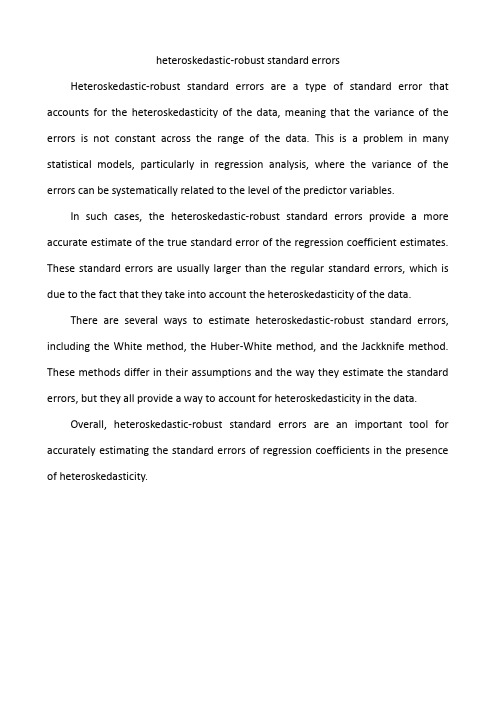
heteroskedastic-robust standard errorsHeteroskedastic-robust standard errors are a type of standard error that accounts for the heteroskedasticity of the data, meaning that the variance of the errors is not constant across the range of the data. This is a problem in many statistical models, particularly in regression analysis, where the variance of the errors can be systematically related to the level of the predictor variables.In such cases, the heteroskedastic-robust standard errors provide a more accurate estimate of the true standard error of the regression coefficient estimates. These standard errors are usually larger than the regular standard errors, which is due to the fact that they take into account the heteroskedasticity of the data.There are several ways to estimate heteroskedastic-robust standard errors, including the White method, the Huber-White method, and the Jackknife method. These methods differ in their assumptions and the way they estimate the standard errors, but they all provide a way to account for heteroskedasticity in the data.Overall, heteroskedastic-robust standard errors are an important tool for accurately estimating the standard errors of regression coefficients in the presence of heteroskedasticity.。
Robust Control
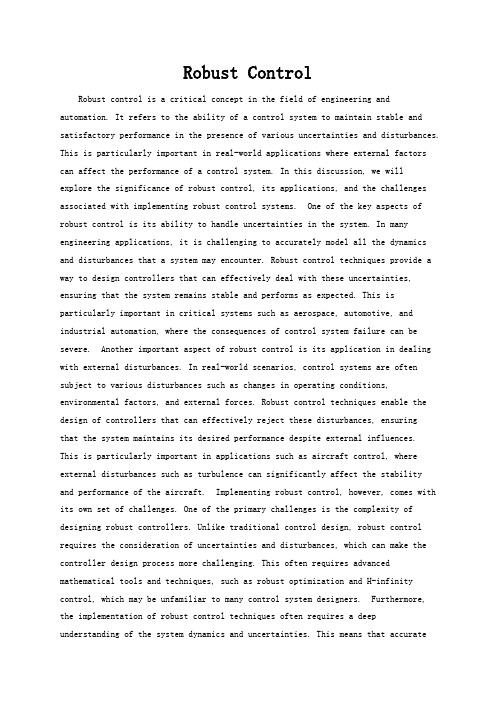
Robust ControlRobust control is a critical concept in the field of engineering and automation. It refers to the ability of a control system to maintain stable and satisfactory performance in the presence of various uncertainties and disturbances. This is particularly important in real-world applications where external factors can affect the performance of a control system. In this discussion, we willexplore the significance of robust control, its applications, and the challenges associated with implementing robust control systems. One of the key aspects of robust control is its ability to handle uncertainties in the system. In many engineering applications, it is challenging to accurately model all the dynamics and disturbances that a system may encounter. Robust control techniques provide a way to design controllers that can effectively deal with these uncertainties, ensuring that the system remains stable and performs as expected. This is particularly important in critical systems such as aerospace, automotive, and industrial automation, where the consequences of control system failure can be severe. Another important aspect of robust control is its application in dealing with external disturbances. In real-world scenarios, control systems are often subject to various disturbances such as changes in operating conditions, environmental factors, and external forces. Robust control techniques enable the design of controllers that can effectively reject these disturbances, ensuringthat the system maintains its desired performance despite external influences.This is particularly important in applications such as aircraft control, where external disturbances such as turbulence can significantly affect the stabilityand performance of the aircraft. Implementing robust control, however, comes with its own set of challenges. One of the primary challenges is the complexity of designing robust controllers. Unlike traditional control design, robust control requires the consideration of uncertainties and disturbances, which can make the controller design process more challenging. This often requires advanced mathematical tools and techniques, such as robust optimization and H-infinity control, which may be unfamiliar to many control system designers. Furthermore, the implementation of robust control techniques often requires a deep understanding of the system dynamics and uncertainties. This means that accuratemodeling of the system and its uncertainties is crucial for the successful implementation of robust control. In many real-world applications, obtaining accurate models of the system dynamics can be challenging, which can further complicate the design and implementation of robust control systems. Despite these challenges, the benefits of robust control are significant. By ensuring stability and performance in the presence of uncertainties and disturbances, robust control techniques can enhance the reliability and safety of critical systems. This is particularly important in applications such as autonomous vehicles, where the ability to maintain stable and predictable behavior in various operating conditions is crucial for ensuring the safety of passengers and pedestrians. In conclusion, robust control is a vital concept in the field of engineering and automation. Its ability to handle uncertainties and disturbances makes itessential for the design of reliable and high-performance control systems. While implementing robust control techniques comes with its challenges, the benefits it offers in terms of system reliability and safety make it a crucial area of research and development in the field of control systems. As technology continues to advance, the importance of robust control will only grow, ensuring thestability and performance of critical systems in the face of uncertainties and external disturbances.。
故障信号随机发生的故障依赖检测方法
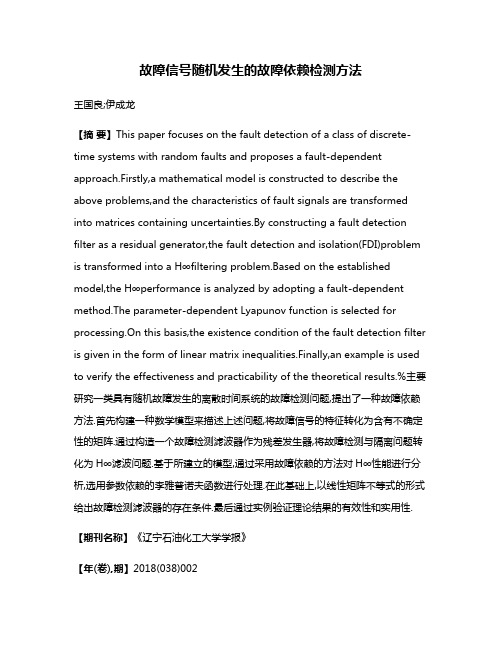
故障信号随机发生的故障依赖检测方法王国良;伊成龙【摘要】This paper focuses on the fault detection of a class of discrete-time systems with random faults and proposes a fault-dependent approach.Firstly,a mathematical model is constructed to describe the above problems,and the characteristics of fault signals are transformed into matrices containing uncertainties.By constructing a fault detection filter as a residual generator,the fault detection and isolation(FDI)problem is transformed into a H∞filtering problem.Based on the es tablished model,the H∞performance is analyzed by adopting a fault-dependent method.The parameter-dependent Lyapunov function is selected for processing.On this basis,the existence condition of the fault detection filter is given in the form of linear matrix inequalities.Finally,an example is used to verify the effectiveness and practicability of the theoretical results.%主要研究一类具有随机故障发生的离散时间系统的故障检测问题,提出了一种故障依赖方法.首先构建一种数学模型来描述上述问题,将故障信号的特征转化为含有不确定性的矩阵.通过构造一个故障检测滤波器作为残差发生器,将故障检测与隔离问题转化为H∞滤波问题.基于所建立的模型,通过采用故障依赖的方法对H∞性能进行分析,选用参数依赖的李雅普诺夫函数进行处理.在此基础上,以线性矩阵不等式的形式给出故障检测滤波器的存在条件.最后通过实例验证理论结果的有效性和实用性.【期刊名称】《辽宁石油化工大学学报》【年(卷),期】2018(038)002【总页数】9页(P71-79)【关键词】故障检测与隔离;故障依赖方法;随机故障;H∞滤波;线性矩阵不等式【作者】王国良;伊成龙【作者单位】辽宁石油化工大学信息与控制工程学院,辽宁抚顺113001;辽宁石油化工大学信息与控制工程学院,辽宁抚顺113001【正文语种】中文【中图分类】TP273随着科学技术的迅猛发展,现代工业系统的规模越来越大,结构变得越来越复杂。
基于收缩极限学习机的故障诊断鲁棒方法
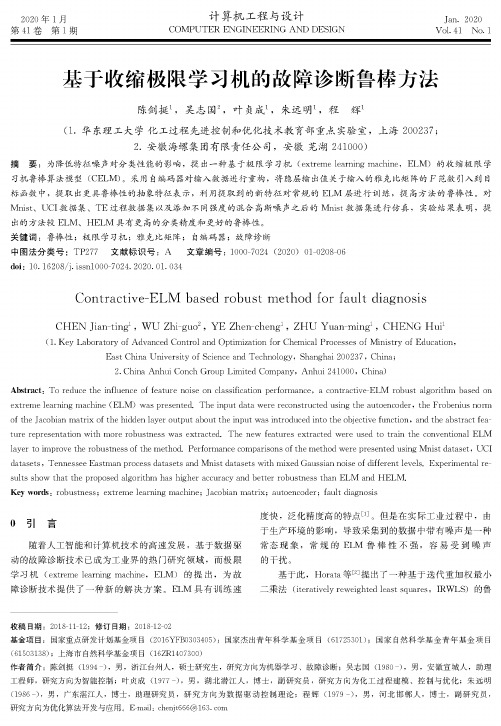
Contractive-ELM based robust method for fault diagnosis
CHEN Jian-ting1, WU Zhi-guo2, YE Zhen-cheng1, ZHU Yuan-ming1, CHENG Hui1
(1. Key Laboratory of Advanced Control and Optimization for Chemical Processes of Ministry of Education, East China University of Science and Technology, Shanghai 200237, China; 2. China Anhui Conch Group Limited Company, Anhui 241000, China)
第41卷 第1期 陈剑挺,吴志国,叶贞成,等:基于收缩极限学习机的故障诊断鲁棒方法 ・209・
2引言
随着人工智能和计算机技术的高速发展,基于数据驱 动的故障诊断技术已成为工业界的热门研究领域,而极限 学习机(extreme learning machine, ELM)的提出,为故 障诊断技术提供了一种新的解决方案。ELM具有训练速
度快,泛化精度高的特点⑴。但是在实际工业过程中,由 于生产环境的影响,导致采集到的数据中带有噪声是一种 常态现象&常规的ELM鲁棒性不强,容易受到噪声 的干扰。
) 2.安徽海螺集团有限责任公司,安徽芜湖241000
摘 要:为降低特征噪声对分类性能的影响,提出一种基于极限学习机(extreme learningmachine, ELM)的收缩极限学 习机鲁棒算法模型(CELM)。采用自编码器对输入数据进行重构,将隐层输出值关于输入的雅克比矩阵的F范数引入到目 标函数中,提取出更具鲁棒性的抽象特征表示,利用提取到的新特征对常规的ELM层进行数据集以及添加不同强度的混合高斯噪声之后的Mmst数据集进行仿真,实验结果表明,提 出的方法较ELM、HELM具有更高的分类精度和更好的鲁棒性% 关键词:鲁棒性;极限学习机;雅克比矩阵;自编码器;故障诊断 中图法分类号:TP277 文献标识号:A 文章编号:1000-7024 (2020) 010208-06 doi: 10. 16208/j. issnl000-7024. 2020. 01 034
基于滑模观测器和广义观测器的故障估计方法
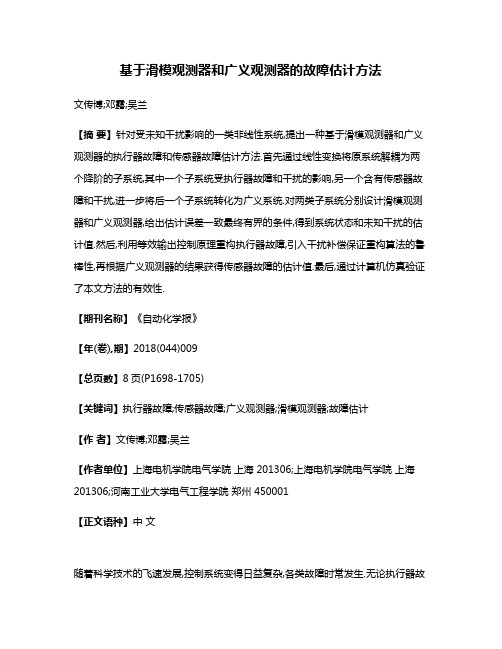
基于滑模观测器和广义观测器的故障估计方法文传博;邓露;吴兰【摘要】针对受未知干扰影响的一类非线性系统,提出一种基于滑模观测器和广义观测器的执行器故障和传感器故障估计方法.首先通过线性变换将原系统解耦为两个降阶的子系统,其中一个子系统受执行器故障和干扰的影响,另一个含有传感器故障和干扰,进一步将后一个子系统转化为广义系统.对两类子系统分别设计滑模观测器和广义观测器,给出估计误差一致最终有界的条件,得到系统状态和未知干扰的估计值.然后,利用等效输出控制原理重构执行器故障,引入干扰补偿保证重构算法的鲁棒性,再根据广义观测器的结果获得传感器故障的估计值.最后,通过计算机仿真验证了本文方法的有效性.【期刊名称】《自动化学报》【年(卷),期】2018(044)009【总页数】8页(P1698-1705)【关键词】执行器故障;传感器故障;广义观测器;滑模观测器;故障估计【作者】文传博;邓露;吴兰【作者单位】上海电机学院电气学院上海 201306;上海电机学院电气学院上海201306;河南工业大学电气工程学院郑州 450001【正文语种】中文随着科学技术的飞速发展,控制系统变得日益复杂,各类故障时常发生.无论执行器故障还是传感器故障都将影响系统的性能,甚至导致系统的不稳定,进而引发严重的安全事故.为了增加系统的可靠性,及时做出故障诊断就显得尤为重要[1−3].相较于故障检测和隔离,故障估计直接获得故障的幅值,还可为进一步实现故障调节和容错控制服务.因此故障估计更具有实际意义,但同时困难也大.故障估计的众多技术中,基于各类观测器的估计方法受到研究人员的青睐,取得了丰富的研究成果[4−5].当执行器发生故障时,文献[6]依次研究了正常系统和不确定系统的故障估计问题,提出了相应的自适应观测器,还通过调整参数增强了算法的鲁棒性.针对多输入多输出系统的执行器故障,文献[7]利用降阶的卡尔曼滤波器联合估计了系统状态和故障,并设计控制器消除故障带来的影响.在此基础上,文献[8]进一步研究了非线性广义系统执行器故障的鲁棒估计和故障容错问题.针对一类不满足利普希茨条件的非线性不确定系统,文献[9]通过解一组线性矩阵不等式和设计多个滑模观测器依次实现了故障检测、隔离和估计.滑模观测器同样被应用在一类线性时变系统的执行器故障估计中,其中设计的观测器增益包含了干扰矩阵的信息,从而保证了观测器的稳定性[10−11].当传感器发生故障时,通常将传感器故障转化为伪执行器故障,再利用已有的方法实现重构[2,12−15].例如,文献[2]提出的两种方法均是将传感器故障转化为执行器故障,再分别设计滑模观测器得到故障的估计值,并论证观测器存在的充分条件.文献[12]首先设计执行器故障的滑模观测器,而后通过系统变换,用类似的方法解决了传感器故障的重构问题,并将结果进一步推广到广义系统.文献[13]针对一类非线性系统,研究了传感器故障、系统噪声和输出噪声同时存在时的故障估计问题,得到了系统状态和传感器故障的联合估计值.通过将系统解耦为两个子系统,文献[14]实现了一类不确定系统的故障观测器设计,并将系统稳定性的问题转化为求解一个线性矩阵不等式问题.文献[15]设计了同时实现状态与执行器故障联合估计的未知输入观测器,并将其应用到传感器故障诊断中.实际应用中,系统的故障往往并非单独发生的,更多的是出现执行器和传感器并发故障,还时常受未知干扰的干扰.对于这类故障,文献[16]针对一类非线性系统设计了同时实现两类故障估计的观测器,但未考虑外界干扰带来的影响.文献[17]对于受缓变干扰影响的系统,给出了干扰的自适应估计方法,在此基础上重构了干扰和传感器故障,但该方法对故障的形式有严格的限制.文献[18]进一步研究了含有执行器故障、传感器故障且受未知干扰系统的故障重构问题,利用滑模抵消干扰的影响,估计了传感器故障,但只能实现执行器故障的检测,却无法重构.因此,能同时估计执行器故障和传感器故障及干扰的方法,有待进一步的研究.本文针对一类同时存在执行器故障、传感器故障和未知干扰的非线性系统,开展故障估计的研究.首先,利用非奇异变换将原系统转化为两个降阶的子系统;然后,设计广义观测器方法估计部分状态变量及传感器故障,同时给出干扰的自适应估计算法;接着设计带干扰补偿的滑模观测器,结合等效输出控制原理重构执行器故障;最后,用计算机仿真验证本文算法的有效性.1 模型描述考虑如下的非线性系统:其中,为系统状态变量,为输入,为测量输出.和分别表示范数有界的执行器故障和传感器故障,满足,其中∂和ω均为正标量,为未知干扰,是系统的已知非线性部分,在区域Ξ上满足Lipschitz条件:,是已知的Lipschitz常数,A、B、C、D、M和F是已知的适维矩阵.不失一般性,假设C、D和M列满秩,对于传感器故障分布矩"阵F#,存在非奇异变换S0使得F满足:.假设1.系统(A,D,C)满足:假设2.系统(A,M,C)满足:引理1 [3].对于故障系统(1)和(2),若假设1的式(3)成立,则存在非奇异变换矩阵T 和S,使得:其中,均为可逆矩阵.相应的,令,原系统变为如下两个降阶的子系统.子系统1:2 观测器设计在第1节解耦所得两个降阶系统的基础上,本节将分别设计广义观测器和滑模观测器,在得到系统状态以及未知干扰的估计值,为下节重构执行器和传感器故障做准备. 对子系统(13),(14)和(11),(12)分别设计观测器:因此,当时,式(25)成立,状态估计误差和干扰估计误差一致最终有界.□注1.假设3中的式(15)和秩条件rank(C1D1)=rank(D1)是子系统1滑模观测器存在的条件[1].而由rank(CD)=,可知式(3)保证了该条件的成立。
国外大学部分现用教材及教学参考书第24部分
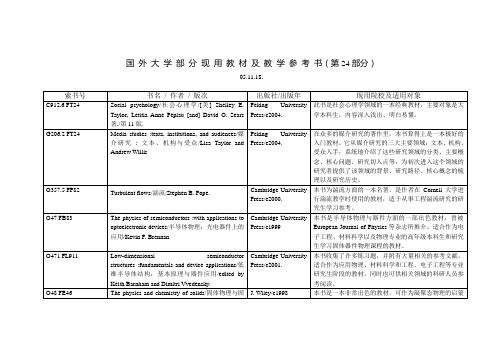
Video coding with superimposed motion-compensated signals :applications to H.264 and beyond/采用多重运动补偿信号的视频编码:在H.264中的应用/by Markus Flierl, Bernd Girod/The Kluwer International series in engineering and computer science SECS 760
Kluwer Academic Publishers/c1999
本书第一次试图规范故障诊断的语言体系,全面、详尽的介绍了基于模型的故障诊断技术的基本概念和结论。本书既适合工业领域的技术人员阅读,也可以作为硕士或博士研究生的课程参考书。
TP13FC511
Control-oriented system identification :an H [infinity] approach/控制导向系统的辨识——基于H的方法/Jie Chen and Guoxiang Gu.
CambridgeUniversityPress/c1999
本书是半导体物理与器件方面的一部出色教材,曾被European Journal of Physics等杂志所推介。适合作为电子工程、材料科学以及物理专业的高年级本科生和研究生学习固体器件物理课程的教材。
O471FL911
Low-dimensional semiconductor structures :fundamentals and deviceapplications/低维半导体结构:基本原理与器件应用/edited by Keith Barnham and Dimitri Vvedensky.
容错控制理论及其应用
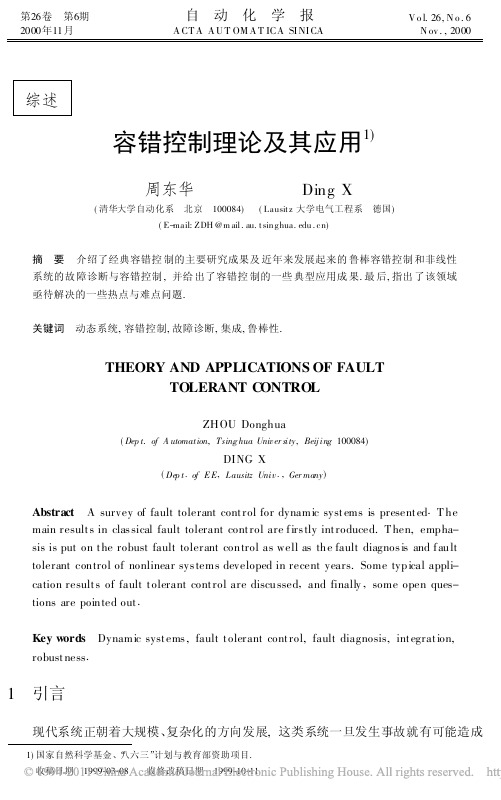
第26卷 第6期2000年11月自 动 化 学 报A CT A A U T OM A T ICA SI NI CA V o l.26,N o.6N ov.,20001)国家自然科学基金、“八六三”计划与教育部资助项目.收稿日期 1999-03-08 收修改稿日期 1999-10-11综述容错控制理论及其应用1)周东华(清华大学自动化系 北京 100084) Ding X (Lausitz 大学电气工程系 德国)(E-mail:ZDH @m ail.au.tsin )摘 要 介绍了经典容错控制的主要研究成果及近年来发展起来的鲁棒容错控制和非线性系统的故障诊断与容错控制,并给出了容错控制的一些典型应用成果.最后,指出了该领域亟待解决的一些热点与难点问题.关键词 动态系统,容错控制,故障诊断,集成,鲁棒性.THEORY AND APPLICATIONS OF FAULTTOLERANT C ONTROLZHOU Donghua(Dep t .of A utomation ,Tsing hua Univer sity ,Beij in g 100084)DING X(De p t .of E E ,L ausitz Univ .,Ger ma ny )Abstract A survey of fault tolerant cont rol for dynamic syst ems is present ed .T hemain result s in classical fault tolerant cont rol are f irstly int roduced.T hen,empha-sis is put on t he robust fault tolerant control as well as the fault diagnosis and f aulttolerant control of nonlinear systems developed in recent years.Some typical appli-cation result s of fault t olerant cont rol are discussed ,and finally ,some open ques-tions are pointed out .Key words Dynamic syst ems,fault t olerant cont rol,fault diagnosis,int egrat ion,robust ness .1 引言现代系统正朝着大规模、复杂化的方向发展,这类系统一旦发生事故就有可能造成人员和财产的巨大损失.如1998年8月到1999年5月的短短的10个月间,美国的3种运载火箭“大力神”、“雅典娜”、“德尔他”共发生了5次发射失败,造成了30多亿美元的直接经济损失,迫使美国航天局于1999年5月下令停止了所有的商业发射计划,对美国的航天计划造成了严重的打击.因此,人们迫切需要提高现代系统的可靠性与安全性.基于解析冗余的动态系统的故障诊断与容错控制则为提高复杂系统的可靠性开辟了一条新的途径.动态系统的容错控制(Fault T olerant Co ntrol,FTC)是伴随着基于解析冗余的故障诊断技术的发展而发展起来的.如果在执行器、传感器或元部件发生故障时,闭环控制系统仍然是稳定的,并仍然具有较理想的特性,就称此闭环控制系统为容错控制系统[1].1991年,瑞典的Astrom 教授明确指出容错控制具有使系统的反馈对故障不敏感的作用.容错控制方法一般可以分成两大类,即被动容错控制(passiv e FT C)和主动容错控制(ac-tiv e FT C ).容错控制的思想最早可以追溯到1971年,以Niederlinski 提出完整性控制(integral co ntrol)的新概念为标志[2];Siljak [3]于1980年发表的关于可靠镇定的文章是最早开始专门研究容错控制的文章之一.然而,直到1993年,国际上才出现了由现任IFAC 技术过程的故障诊断与安全性专业委员会主席Patton 教授撰写的容错控制的综述文章[1,4],目前尚未见到国外有容错控制的专著问世.值得指出的是,我国在容错控制理论上的研究基本上与国外同步.1987年叶银忠等就发表了容错控制的论文,并于次年发表了这方面的第一篇综述文章[5].1994年葛建华等出版了我国第一本容错控制的学术专著[5].国内发表的这方面的综述文章还有文[6].动态系统的故障检测与诊断(Fault Detection and Diagnosis,FDD)是容错控制的重要支撑技术之一.FDD 技术的发展已大大超前于容错控制的发展,其理论与应用成果也远远多于容错控制方面的成果.目前国际上每年发表的有关FDD 方面的论文与报告在数千篇以上.基于解析冗余的故障诊断技术被公认为起源于Bear d 在1971年发表的博士论文[7].1976年,W illsky 在Auto matica 上发表了第一篇FDD 方面的综述文章[8].Him-melblau 于1978年出版了国际上第一本FDD 方面的学术著作[9].随后报导的这方面的重要综述文章与著作参见文[10~16].我国开始FDD 技术的研究要比国外晚十年左右.清华大学的方崇智教授等从1983年起开始了FDD 技术的研究工作.1985年叶银忠等在《信息与控制》上发表了国内第一篇FDD 技术的综述文章[17].1994年周东华等在清华大学出版社出版了国内第一本FDD 技术的学术专著[18].随后几年出版的学术著作还有文[19]和文[20].国际自动控制界对容错控制的发展给予了高度重视.1986年9月在美国Santa Clara 大学举行的自动控制高峰会议上,把多变量鲁棒、自适应和容错控制列为控制科学面临的富有挑战性的研究课题[21].在国际上,领导着容错控制学科发展的是1993年成立的I-FAC 技术过程的故障诊断与安全性技术委员会.从1991年起IFAC 每三年定期召开FDD 与FT C 方面的国际专题学术会议.在近几届的IFAC 世界大会上,FDD 与FT C 方面的论文在不断增加.据笔者统计,1999年7月在北京召开的第14届IFAC 世界大会上,这方面的学术论文已达60篇,成为了最热门的几个研究方向之一[22~26].容错控制发展至今只有20年左右的历史,因此这是一门新兴交叉学科.促使这门学科789 6期周东华等:容错控制理论及其应用790自 动 化 学 报26卷迅速发展的一个最重要的动力来源于航空航天领域.美国空军从70年代起就不断投入巨资支持容错控制的发展,力求开发出具有高度容错能力的战斗机,甚至在多个翼面受损时,也能够保持战斗机的生存能力.做为一门交叉性学科,容错控制与鲁棒控制、故障检测与诊断、自适应控制、智能控制等有密切的联系.现代控制理论、信号处理、模式识别、最优化方法、决策论、统计数学等构成了容错控制的理论基础.2 经典容错控制方法2.1 被动容错控制被动容错控制大致可以分成可靠镇定,完整性,联立镇定三种类型.2.1.1 可靠镇定使用多个补偿器进行可靠镇定的概念是由Siljak于1980年最先提出的[3],随后一些学者又对其进行了深入研究[29~33].可靠镇定实际上是关于控制器的容错问题.针对单个被控对象,文[29]证明了当采用两个补偿器时,存在可靠镇定解的充要条件是被控对象是强可镇定的(strongly stabilizable),即此对象可以被稳定的控制器所镇定.然而,当被控对象不满足强可镇定条件时,补偿器就会出现不稳定的极点,受过程噪声的影响,闭环系统就会出现不稳定.文[29]方法的另外一个缺点是,即使可靠镇定问题是可解的,怎样设计这两个补偿器也是一个非常困难的问题.文[31]部分解决了上述问题,给出了设计两个动态补偿器的参数化方法,以得到可靠镇定问题的解.此文还给出了把一个稳定的控制器分解成两个并联的动态补尝器,进而实现可靠镇定问题的有效方法,其前提仍然是被控对象必须是强可镇定的.文[32]进一步给出了一个新颖的可靠镇定问题的求解方法,即使对不是强可镇定的多变量系统依然有效,其设计思路是采用多个并列的动态补偿器(可大于两个).与传统方法不同的是,这里每个补偿器需要其它补偿器的输出信号,因此就需要辅助的传感器来观测其它执行器的运行状况[32].综上所述,可靠镇定问题已基本上趋于成熟.2.1.2 完整性完整性问题也称作完整性控制(integral co ntro l),它一直是被动容错控制中的热点研究问题.此问题之所以有很高的应用价值,是因为控制系统中传感器是最容易发生故障的部件.此问题研究的一般都是M IM O线性定常系统[34~39].文[35]研究了关于执行器断路故障的完整性问题,提出了求解静态反馈增益阵的一种简单的伪逆方法.然而,该方法并不能保证故障状态下的闭环系统是稳定的.基于n-线性特征系数理论及参数空间设计方法,文[37]给出了关于执行器断路故障的完整性问题的求解方法.该方法的一个特点是可以在实现完整性的同时,在执行器的各种故障下,都可以将系统的闭环极点配置在预定的区域内.因此,此方法在满足容错控制的条件下还可以兼顾闭环系统的动态特性.该方法的一个缺陷是,当系统的维数大于3时,解析解就不再存在,只能采用CAD技术来求数值解,并可能无解.此外,近年来分散大系统的完整性问题也受到了广泛关注[38,39].由此可见,完整性问题还远未彻底解决.缺乏有效地求解容错控制律的构造性方法,尤其是对高维多变量系统.2.1.3 联立镇定联立镇定有两个主要作用.其一,当被控对象发生故障时,可以使其仍然保持稳定,具有容错控制的功能;其二,对非线性对象,经常采用线性控制方法在某一工作点上对其进行控制.当工作点变动时,对应的线性模型也会发生变化.此时,具有联立镇定能力的控制器就仍然可以镇定被控对象.此问题十几年来已引起了许多学者的关注[40~44].1982年发表在IEEE AC 上的文[41]是最早开始研究联立镇定问题的文章之一.文[43]在此方向上取得了重要进展.基于广义的采样数据保持函数,该文得到了如下结果:a)给出了联立镇定问题有解的充分条件,及其控制律的构造方法;b)给出了在满足联立镇定的基础上同时实现线性二次型最优控制的充分条件,以及相应的控制律的构造方法.2.2 主动容错控制主动容错控制在故障发生后需要重新调整控制器的参数,也可能需要改变控制器的结构.多数主动容错控制需要FDD 子系统,少部分不需要FDD 子系统,但需要已知各种故障的先验知识.主动容错控制这一概念正是来源于需要对发生的故障进行主动处理这一事实.众多的FDD 方法可以分成基于定性模型的方法与定量模型的方法两大类.经过近30年的发展,FDD 技术已日趋成熟,所提出的各种方法详见文[7~20,23~28].主动容错控制大致可以分成三大类:1)控制律重新调度;2)控制器重构设计;3)模型跟随重组控制.2.2.1 控制律重新调度这是一类最简单的也是最近几年才发展起来的主动容错控制方法.其基本思想是离线计算出各种故障下所需的合适的控制律的增益参数,并列表储存在计算机中.当基于在线FDD 技术得到了最新的故障信息后,就可以挑选出一个合适的增益参数,得到容错控制律[45~49].显然,采用实时专家系统进行增益调度将会产生很好的效果.这类控制方法特别适合于具有多个冗余机翼的战斗机的容错控制[4,45].2.2.2 控制律重构设计在FDD 单元确诊故障后,在线重组或重构控制律.这是一个目前很受关注的研究方向,现有的成果还比较少[1,50~54].文[51]采用“控制混合器”的概念,设计了一个具有自修复功能的飞行控制系统,当诊断出某个机翼受损时,可以重新分配其应尽的作用到剩余的执行器中去.该文还提出了一种控制器的重新设计技术,通过极大化一个频域的性能指标,来重建控制律.文[54]给出了一种飞机的模型参考容错控制方法,针对飞机的元部件故障,该文用检测滤波器理论设计了相应的故障检测器和故障参数估计器.在此基础上,用Lyapunov 方法设计了模型参考容错控制律,保证在发生内部故障时,飞机稳定运行.该文还提出了一种分析这类容错控制系统稳定性的随机微分方程方法.其主要结果是,由于随机微分方程的参数是随时间的变化而随机变化的,所以此方程可以由马尔可夫过程来描述.文[55]提出了一种基于实时专家系统的容错监督控制方法.其基本思想是,采用基于影响图的实时专家系统监督系统的运行.系统正常运行时,采用模型参考学习自适应控制律,以提高控制精度;当检测到系统已处于不稳定的边沿时,将控制律实时切791 6期周东华等:容错控制理论及其应用792自 动 化 学 报26卷换到一种简单的PI控制器,仍然使系统保持稳定.2.2.3 模型跟随重组控制这类主动容错控制的基本原理是,采用模型参考自适应控制的思想,使得被控过程的输出始终自适应地跟踪参考模型的输出,而不管是否发生了故障.因此,这种容错控制不需要FDD单元.当发生故障后,实际被控过程会随之发生变动,控制律就会相应地自适应地进行重组,保持被控对象对参考模型输出的跟踪[56~58].可以看出,这类容错控制是采用隐含的方法来处理故障的.文[59]进一步提出了一种基于模糊学习系统的专家监督控制方法,用于F16战斗机的容错控制.其基本控制器是由参考模型、模糊控制器及模糊学习模块构成的,称为模糊模型参考学习控制器.模糊学习模块使这一控制器具有上述模型跟随重组控制的基本功能.在此基础上,通过与一个FDI模块相结合,可以在线选择合适的参考模型和模糊控制器的输出增益,进一步提高了容错控制能力.因此,该方法也可以看成是模型跟随重组控制与控制律重构设计的一种有机结合.3 鲁棒容错控制不管是主动容错控制,还是被动容错控制,都需要具有关于模型不确定性与外界扰动的鲁棒性.被动容错控制的核心就是鲁棒性,以使闭环系统对各类故障不敏感.目前主动容错控制面临的两个具有挑战性的问题就是[58]:1)基本控制器应具有鲁棒性,在控制律重构期间使系统保持稳定;2)FDD单元应具有鲁棒性,以减少误报与漏报,减少故障检测时间.因此,鲁棒容错控制问题近年来受到了高度重视[1,60~63],已成为目前容错控制领域的热点研究方向.针对连续线性定常系统的传感器失效故障,文[60]采用Lyapunov方法给出了一种具有关于模型不确定性鲁棒性的完整性控制器存在的充分条件,并给出了控制器的设计方法.文[61]讨论了离散线性定常系统的鲁棒完整性控制问题,通过求解Riccati方程,分别得到了一种传感器失效下的鲁棒容错线性调节器的设计方法,以及执行器失效下的鲁棒容错线性调节器的设计方法.文[62]进一步探讨了离散系统的D稳定鲁棒完整性控制问题.所谓的D稳定就是闭环系统的极点都要位于圆形区D( ,r)内.该文给出了关于传感器失效故障的存在D稳定鲁棒完整性控制的充分条件,以及控制律的求解方法.尚待进行的工作是,对高维系统,上述文章所给出的设计方法有待改进,以提高设计效率.4 非线性系统的故障诊断与容错控制由上面的分析可知,被动容错控制均不采用FDD技术,因此也就不能提供系统的故障信息.在发生故障后,与系统正常运行时相比,被动容错控制系统的性能(至少是动态性能)会有所下降.另外,经典的被动容错控制讨论的对象都是线性系统.为了克服上述缺陷,文[64,65]将FDD技术与被动容错控制相结合,提出了一种关于非线性系统传感器故障的集成故障诊断与容错控制方法.此方法的优点是:1)可处理多种传感器故障,包括断路、增益衰减、加性与乘性偏差等,因此克服了传统的完整性控制问题只能处理失效故障的缺陷;2)在发生故障时,闭环系统的性能指标几乎不受影响;3)适用于一大类(带随机噪声的)非线性系统;4)不管对低维还是高维系统,设计方法都同样简单[18,66].此外,文[27]采用非线性状态空间模型,提出了一种关于都市交通网络系统的容错控制方法,在系统发生某些故障时,可以保持系统的稳定;文[67]提出了一种基于预测控制的执行器容错控制方法,并用某一飞机操纵系统的模型进行了仿真研究;文[68]给出了一种基于自适应神经元网络的非线性系统的容错控制方法,通过采用一个辅助的回路,来补偿系统中较大的输入输出扰动.5 容错控制理论的应用成果尽管容错控制理论不像FDD 技术那样已经在众多的领域取得了大量应用成果,但仍然取得了一些重要的应用成果,由表1列出.表1 容错控制典型应用实例一览表序号应用对象采用方法发表时间文献1航天飞机控制律重构设计1982[74]2飞机模型跟随重组控制1988,1988[69,70]控制律重构设计1985,1988,1995,1998[52,77][78]控制律重新调度1989[45]3核反应堆控制律重构设计1991,1995[71,72]4液位系统完整性控制1991[73]5国产歼击机模型跟随重组控制1991[53]6地空导弹模型跟随重组控制1993[75]7精馏塔控制律重构设计1994[76]8人造卫星控制律重构设计1997[79]9液体冷却系统控制律重构设计1997[79]10化学反应釜集成故障诊断与容错控制1998[65]表1表明,容错控制取得应用成果最多的对象是飞机;主动容错控制的应用成果要远远多于被动容错控制所取得的成果,其中控制律重构设计方法应用得最多.这些应用成果的分布情况也从一个侧面验证了Patton 教授的一个著名论断(见文[4],pp.1050),即“离开了FDD 单元,容错控制所能发挥的作用就会非常有限,只能对一些特殊类型的故障起到容错的作用”.因此可以肯定,主动容错控制在总体上要优于被动容错控制.6 结束语容错控制做为一门新兴的交叉学科,其学科意义就是要尽量保证动态系统在发生故障时仍然可以稳定运行,并具有可以接受的性能指标.因此,容错控制为提高复杂动态系统的可靠性开辟了一条新的途径.由于任何系统都不可避免地会发生故障,因此,容错控制也可以看成为是保证系统安全运行的最后一道防线.除第3节介绍的鲁棒容错控制以外,当前容错控制中的热点问题还有以下一些.793 6期周东华等:容错控制理论及其应用794自 动 化 学 报26卷1)快速FDI方法的研究.故障检测与分离都需要一定时间,造成了一定的时延,这段时延越短,对控制律的重构设计就越有利.这段时延有可能会产生非常严重的稳定性问题,除非原来的基础控制器本身就具有很高的完整性和很强的鲁棒性[4].2)鲁棒故障检测与鲁棒控制的集成设计问题.鲁棒故障检测的目标是,在一定的模型不确定性下,检测出尽可能小的故障;鲁棒控制的目标是使得控制器对模型不确定性与微小的故障不敏感.因此,这两者存在着矛盾,而它们都是鲁棒容错控制的基本问题.所以说,把鲁棒故障检测与鲁棒控制进行统一设计,把上面的两种目标进行折衷,已成为热点研究课题[24].3)控制律的在线重组与重构方法.做为主动容错控制的一种最重要的方法,控制律的在线重组与重构已成为当前容错控制领域的热点研究方向之一.只有在被控对象发生变动时,实时调整控制器的结构与参数,才有可能达到最优的控制效果[56~58].4) 主动容错控制中的鲁棒性分析与综合方法.在主动容错控制中,需要同时做到:a)基础控制器具有鲁棒性,b)故障检测与诊断算法具有鲁棒性,c)重组或重建的控制律具有鲁棒性.这三个方面的相互作用使得对主动容错控制的整体鲁棒性分析变得非常困难[4].除了上述热点研究方向以外,因现有的理论结果还非常有限,容错控制领域还有一些难点问题.1) 非线性系统的容错控制.这里的主要难点是:a)对非线性系统缺乏一般性的控制器综合方法;b)非线性系统的FDD问题还没有得到完全解决.2) 时滞动态系统的容错控制.非线性时滞系统的容错控制还没有任何结果,线性时滞系统容错控制的结果还非常有限.3) 高维、时变多变量系统的完整性控制问题.此问题目前还没有任何结果,经典的完整性问题研究的对象都是线性定常系统.4) 自适应容错控制问题.其学术上的难点是,自适应控制系统是本质非线性系统,因此自适应容错控制属于非线性容错控制的范畴.此问题也还没有任何结果.经过20多年的发展,容错控制已经取得了很大的进展,并正处于快速发展之中.但容错控制还远未成熟,还没有建立起完整的理论体系,尤其在应用方面还有许多问题有待解决,还需要大家继续努力,可谓任重而道远.参考文献1 Patton R J.Robus tnes s is sues in fault tolerant control.In:Pr oc.of In ternational Conference on Fault Diagnos is, T ou louse,France,1993,1081~11172 Niederlinski A.A heuristic approach to th e design of interacting multi-variable systems.A utomatica,1971,7: 691~7013 Saljak D D.Reliable control usin g mu ltiple control systems.Int.J.Control,1980,31:303~3294 Patton R J.Fault-toleran t control:th e1997s ituation.In:Proc.of IFAC/IM ACs Sympos ium on Fault Detection and S afety for T echnical Process.Hu ll,England,1997,1033~10555 葛建华,孙优贤.容错控制系统的分析与综合.杭州:浙江大学出版社,19946 南英,陈士橹,戴冠中.容错控制进展.航空与航天,1993,(4),62~677 Beard R V.Failure accommodation in linear sys tems th rough s elf-reorgan ization.In:Report M VT-71-1,M an Veh icle Lab,M IT,C amb ridge,M ass achusetts,19718 Wills ky A S .A su rvey of des ign methods for failure detection in dynamic sys tems .A utomatica ,1976,12:601~6119 Himm elblau D M.Fau lt Detection and Diagnosis in Chemical an d Petrochemical Process.Amster dam :Elsevier Pres s .197810 Ger tler J J.Survey of model bas ed failur e detection and is olation in com plex plants.I EE E Contr ol Syste ms M aga -z ine ,1988,8(6):3~1111 Isermann R .Proces s fault detection b as ed on m odelin g an d es timation m ethods :a s urvey .Automatica ,1984,20:387~40412 Frank P M.Fault diagnosis in dynam ic sys tems using analytical and know ledge-b as ed redundancy ——a s urveyand s ome new results .A utomatica ,1990,26(3):459~47413 Iserman n R.Fault diagnosis of machines via parameter es timation and know ledge p roces sing :tutorial paper.A u -tomatica ,1993,29(4):815~83514 Basseville M .(eds .)Detection of Ab rupt Changes in Signal and Dynamic Systems .Berline :Sp ringer -Verlag ,198515 Patton R et al .(eds.)Fault Diagnos is in Dynamic Sys tems.New York:Pren tice Hall,198916 Zh ang X J .Aux iliary S ignal Des ign in Fault Detection and Diagnosis .Berlin :Spr inger -Verlag ,199117 叶银忠,潘日芳,蒋慰孙.动态系统的故障检测与诊断方法.信息与控制,1985,14(6):27~3418 周东华,孙优贤.控制系统的故障检测与诊断技术.北京:清华大学出版社,199419 张育林,李东旭.动态系统故障诊断理论与应用.长沙:国防科技大学出版社,199720 闻新,张洪钺,周露.控制系统的故障诊断和容错控制.北京:机械工业出版社,199821 郑应平.控制科学面临的挑战:专家意见综述.控制理论与应用,1987,4(3):1~922 Astrom K J .Intelligent control .Pr oc .of 1st European Control Conference .Grenoble ,1991,2328~232923 周东华,王庆林.基于模型的控制系统故障诊断技术的最新进展.自动化学报,1995,21(2):244~24824 周东华,叶昊,王桂增,Ding X.基于观测器方法的故障诊断技术若干重要问题的探讨.自动化学报,1998,24(3):338~34425 周东华,席裕庚,张钟俊.故障检测与诊断技术.控制理论与应用,1991,8(1):1~1026 张洪钺,闻新,周露.国内控制系统故障诊断技术的现状与展望.火力与指挥控制,1997,22(3):1~627 Ch en Z ,C han g T .M odeling and fau lt -tolerant control of larg e urb an traffic network .In :Proc .of Amer ican Con-trol C on feren ce,1997,4,2469~247228 Isermann R,Balle P.Trends in th e application of model based fault detection and diagnos is of techn ical pr oces s.Control Eng .Practice ,1997,5(5):709~71929 Vidyasagar M ,Vis w anadham N .Reliable s tabiliz ation using a multi-con tr oller configur ation.A utomatica ,1985,21:599~60230 Veillette R J ,M edanic J V ,Perkins W R .Des ign of reliable control sys tems .I EE E Tr ans .A utomatic Control ,1992,37(3):290~30431 Gundes A N.Controller des ign for reliable stab ilization.In:Proc.of 12th IFAC W orld Congress ,1993,4:1~432 Sebe N ,Kitam or i T .Reliable s tabilization based on a multi -com pens ator configur ation .In :Proc .of 12th IFACWorld C ongres s,1993,4:5~833 M edanican d J V,Perk ins W R.Control sys tems pos sessin g reliability to con tr ol.In:Proc.of 12th IFAC W orldCongress ,1993,4:9~1234 M orari M .Robust stability of sys tems w ith integral control.I EE E T rans .on A utomatic Control ,1985,30:574~58835 葛建华,孙优贤,周春辉.故障系统容错能力判别的研究.信息与控制,1989,18(4):8~1136 Nw okah O D I,Yau C H,Perez R A.Robus t integr al stabilization and regu lation of uncertain mu ltivariable s ys-tems.In :Proc.of 12th IFAC W orld Congress ,1993,4:13~1737 Ye Y Z .Fault toleran t pole as signm ent for mu lti -variable s ystems us ing a fixed state feedback .控制理论与应用,795 6期周东华等:容错控制理论及其应用。
模型跟踪
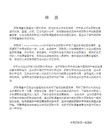
Dynamic surface
backstepping control
模型跟踪的主要思想是让飞控系统的信号和参考
模型的信号实时比较, 将信号误差反馈给控制器以调节
系统的性能, 使之在故障情况下依然与参考模型保持一
致。文献[ 10 ]基于伪逆思想设计了模型跟踪重构方法,
In this paper the rigorous proof of fault diagnosis and self-repairing control comprehensive study on the repair capacity of various faults, this method ensures that the repair time is short, good quality repair process control, repair, and other aspects of the higher capacity needs. The simulation results also support the conclusion.
ence , S an Francisco , US A , 2005 ; 1 - 30.
[ 29 ] Napolitano M R , An Y, Seanor B A. A fault tolerant flight
cont rol system for sensor and act uator failures using neural net2
出一种渐近调节的主动容错控制方案, 在维持系统性能的
同时有效克服了由于故障检测和诊断的延时[ tF , tR ]对系统
故障的英语单词
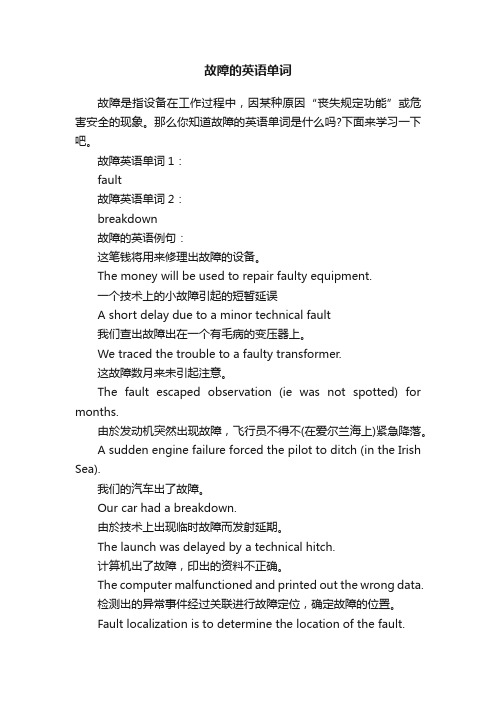
故障的英语单词故障是指设备在工作过程中,因某种原因“丧失规定功能”或危害安全的现象。
那么你知道故障的英语单词是什么吗?下面来学习一下吧。
故障英语单词1:fault故障英语单词2:breakdown故障的英语例句:这笔钱将用来修理出故障的设备。
The money will be used to repair faulty equipment.一个技术上的小故障引起的短暂延误A short delay due to a minor technical fault我们查出故障出在一个有毛病的变压器上。
We traced the trouble to a faulty transformer.这故障数月来未引起注意。
The fault escaped observation (ie was not spotted) for months.由於发动机突然出现故障,飞行员不得不(在爱尔兰海上)紧急降落。
A sudden engine failure forced the pilot to ditch (in the Irish Sea).我们的汽车出了故障。
Our car had a breakdown.由於技术上出现临时故障而发射延期。
The launch was delayed by a technical hitch.计算机出了故障,印出的资料不正确。
The computer malfunctioned and printed out the wrong data.检测出的异常事件经过关联进行故障定位,确定故障的位置。
Fault localization is to determine the location of the fault.论文提出了一个针对路径延迟故障的快速并精确的故障模拟器。
A fast and exact fault simulator is proposed for path delay faults.分析了模拟电路故障诊断中故障类重叠。
人工智能技术让生活更美好英语作文

人工智能技术让生活更美好英语作文全文共3篇示例,供读者参考篇1How AI Technology Makes Life BetterAs a student in the 21st century, I can't help but be in awe of the rapid advancements in artificial intelligence (AI) technology over the past few decades. AI seems to have infiltrated almost every aspect of our lives, from the smart assistants on our phones to the recommendation algorithms that power our favorite streaming platforms. While there are certainly valid concerns about the implications of this powerful technology, I believe that AI has the potential to improve our lives in countless ways.One of the most exciting applications of AI is in the field of healthcare. With the ability to process vast amounts of data and identify patterns that may be imperceptible to human analysts, AI systems are being used to aid in disease diagnosis, drug discovery, and personalized treatment planning. Imagine a future where AI could analyze your genetic makeup, medical history, and lifestyle factors to develop a tailored healthcare planthat maximizes your chances of staying healthy and catching any potential issues early on. This could be a game-changer in terms of improving patient outcomes and reducing healthcare costs.Another area where AI is making a significant impact is in education. AI-powered tutoring systems and adaptive learning platforms can analyze a student's strengths, weaknesses, and learning style, and then tailor the educational content and delivery method accordingly. This personalized approach could help students learn more effectively and efficiently, while also providing valuable insights to teachers on how to better support their students' individual needs. Additionally, AI-powered language translation tools could break down barriers in international communication and knowledge-sharing, fostering a more interconnected and inclusive global community of learners.As someone who loves to travel, I'm also intrigued by the potential of AI in the transportation industry. Self-driving cars and autonomous delivery drones could revolutionize the way we move goods and people, potentially reducing traffic congestion, increasing efficiency, and improving safety on our roads and in the skies. AI-powered route optimization algorithms could alsohelp logistics companies plan more efficient delivery routes, cutting down on fuel consumption and carbon emissions.Beyond these more practical applications, AI is also making its mark in the realm of creativity and entertainment. AI-powered music composition tools can analyze existing songs and genres to generate entirely new musical works, potentially opening up new avenues for artistic expression and collaboration between humans and machines. Similarly, AI-generated art and literature could push the boundaries of what's possible in these creative fields, sparking new ideas and perspectives that might not have emerged otherwise.Of course, with any powerful technology, there are valid concerns and ethical considerations that must be addressed. The potential for AI systems to perpetuate biases present in their training data, or to be used for nefarious purposes like surveillance or manipulation, is a real and pressing issue. There are also legitimate concerns about the potential displacement of human workers by AI-powered automation, and the need to ensure that this technology is developed and deployed in a responsible and equitable manner.However, I believe that these challenges can be overcome through responsible governance, transparent developmentpractices, and a commitment to ethical AI principles. By working to mitigate the risks and potential downsides of AI, while simultaneously fostering its positive applications, we can harness the power of this transformative technology to create a better world for all.As a student, I'm excited to see how AI will continue to shape and influence the world around us in the years to come. From personalized education and healthcare to more efficient transportation and logistics, to new frontiers in creativity and entertainment, the possibilities seem endless. While we must remain vigilant and proactive in addressing the potential risks and ethical concerns, I believe that AI technology has the potential to make our lives easier, more convenient, and ultimately, better.In conclusion, the rapid advancements in AI technology are undoubtedly shaping the world we live in, and will continue to do so in profound ways. As students and members of this increasingly technology-driven society, it's our responsibility to stay informed and engaged in the conversations around AI, to ensure that this powerful tool is harnessed for the greater good of humanity. By embracing the positive applications of AI while remaining mindful of its potential pitfalls, we can work towards afuture where this technology truly makes our lives better in every sense of the word.篇2How AI Technology Makes Life BetterArtificial Intelligence, or AI for short, is one of the most exciting and rapidly advancing fields of technology today. As a student, I can't help but be amazed at the countless ways AI is positively impacting our lives and making the world a better place. From smart home assistants that make everyday tasks more convenient to groundbreaking medical research powered by machine learning, AI is transforming how we live, work, and approach problem-solving.One area where AI shines is in enhancing our modern conveniences and quality of life. Take smart home devices like Amazon's Alexa or Google Home for example. With just a simple voice command, we can set reminders, control our home's lighting and temperature, play our favorite music, and even order household essentials with ease. AI makes these virtual assistants incredibly intuitive, understanding our natural language and responding accordingly. No more fumbling withtiny buttons or memorizing complex commands – AI allows technology to adapt to us instead of the other way around.But AI's benefits extend far beyond hands-free grocery shopping. Recommendation engines powered by AI algorithms are becoming smarter at curating personalized content for us based on our preferences and behaviors. From Netflix's intelligent suggestions for shows and movies to Spotify'sspot-on music recommendations, AI ensures we discover new content tailored to our unique tastes. In our digital world overflowing with choices, this intelligent curation is a gamechanger that saves us countless hours of aimless browsing.AI is also rapidly advancing fields like healthcare and scientific research in ways that will positively impact millions of lives. Machine learning algorithms can analyze vast amounts of medical data, spot patterns invisible to the human eye, and aid in early disease detection and prevention. Google's AI system has already proven capable of detecting breast cancer from mammograms with greater accuracy than human radiologists. As AI continues developing, it holds the potential to accelerate medical breakthroughs, leading to more effective treatments and ultimately saving lives.The possibilities of AI in education are equally exciting. Intelligent tutoring systems can provide adaptive, personalized learning experiences tailored to each student's unique strengths, weaknesses, and pace of learning. No more one-size-fits-all approach – AI can revolutionize how we acquire knowledge. Additionally, AI writing assistants can help students improve their grammar, structure, and overall communication skills by providing intelligent feedback in real-time. As an English student, I can attest to how invaluable such tools are in honing our writing abilities.Looking beyond individual quality-of-life improvements, AI is also tackling some of humanity's grandest challenges. Researchers are leveraging machine learning to develop more sustainable practices in energy, agriculture, and manufacturing. AI systems can optimize energy usage in smart grids, enabling a transition towards renewable sources. Predictive analytics can help farmers increase crop yields while minimizing resource consumption. The potential applications are endless, and AI could very well be our greatest ally in combating climate change and achieving a more eco-friendly future.Of course, with such a transformative technology comes valid concerns over its ethical implications and potential misuse.AI systems can perpetuate human biases if their training data is skewed or lacks diversity. There are also fears about AI displacing human workers or being weaponized for malicious purposes. As AI continues advancing, we must remain vigilant about developing robust governance frameworks that prioritize ethics, transparency, and accountability.Despite these complexities, I firmly believe the positive impacts of AI will far outweigh the risks as long as we approach its development thoughtfully and responsibly. After all, every revolutionary technology carries uncertainties – it's up to us as a society to steer AI in an direction that promotes the greater good of humanity.As a student, I'm endlessly inspired by AI's potential to reshape our world for the better. From empowering our personal lives with seamless conveniences to driving sustainability and life-changing scientific breakthroughs, AI is an incredibly powerful tool awaiting our creative application. It's our responsibility to continue nurturing this technology while upholding ethical principles, so that future generations can experience an AI-augmented world of unprecedented progress and prosperity.In the coming decades, I have no doubt AI will become an indispensable part of our daily lives and society, just as the internet and mobile technology are today. As both creators and consumers of AI, we have a unique opportunity to shape this unfolding revolution in a way that improves lives, solves global issues, and propels humanity towards an incredibly bright future. For me, that's the most exciting prospect – playing a role in harnessing AI's infinite possibilities to create a better world for all.篇3How AI Technology Makes Life BetterAs a student living in the 21st century, I can't help but be in awe of the rapid advancements in artificial intelligence (AI) technology. From digital assistants that can understand and respond to natural language to self-driving cars and intelligent robots, AI seems to be revolutionizing nearly every aspect of our lives. While some may view this technological progress with trepidation, I firmly believe that AI has the potential to vastly improve our quality of life and solve many of the world's most pressing challenges.One of the most tangible ways AI is already enhancing our lives is through the realm of personal assistance. Digital assistants like Siri, Alexa, and Google Assistant have become ubiquitous, allowing us to accomplish tasks and retrieve information with simple voice commands. No longer do we have to fumble with our phones or laptops to set a reminder, check the weather, or find the nearest restaurant. These AI-powered assistants have made our lives more convenient and efficient, freeing up valuable time that can be better spent on more meaningful pursuits.Beyond personal assistance, AI is revolutionizing the field of healthcare. Machine learning algorithms can now analyze vast amounts of medical data, identify patterns, and aid in early disease detection and diagnosis. AI-powered systems can even assist in treatment planning and drug discovery, potentially leading to more effective and personalized therapies. As a result, healthcare professionals can make more informed decisions, improving patient outcomes and potentially saving countless lives.Another area where AI is making a significant impact is in education. Intelligent tutoring systems can adapt to individual learning styles and provide personalized instruction, ensuringthat no student is left behind. AI-powered language learning apps can provide real-time feedback and customized lessons, making the process of acquiring a new language more efficient and engaging. Additionally, AI-powered writing assistants can help students improve their writing skills by providing feedback on grammar, structure, and coherence.Furthermore, AI has the potential to tackle some of the world's most pressing environmental challenges. Machine learning algorithms can be used to analyze climate data, model future scenarios, and identify effective strategies for mitigating the impacts of climate change. AI-powered systems can also optimize energy consumption in buildings and cities, reducing our carbon footprint and promoting sustainability.In the realm of transportation, self-driving cars and intelligent traffic management systems have the potential to significantly reduce road accidents, alleviate traffic congestion, and improve overall mobility. AI-powered vehicles can navigate more efficiently, respond to changing conditions in real-time, and potentially eliminate human error, which is a leading cause of accidents.While the benefits of AI are undeniable, it is crucial to address the ethical considerations and potential risks associatedwith this technology. As AI systems become more advanced and autonomous, concerns arise regarding privacy, bias, and the potential for misuse or unintended consequences. It is imperative that we develop robust ethical frameworks and guidelines to ensure that AI is developed and deployed in a responsible and equitable manner.One of the primary ethical concerns surrounding AI is the issue of privacy and data protection. AI systems rely heavily on vast amounts of data, including personal information, to learn and make decisions. There is a risk that this data could be misused or fall into the wrong hands, compromising individual privacy and security. We must establish clear policies and regulations to govern the collection, storage, and use of personal data, ensuring that individuals have control over their information and that their privacy is protected.Another ethical consideration is the potential for AI systems to perpetuate or amplify existing biases and discrimination. AI algorithms can inherit the biases present in the data they are trained on, leading to unfair or discriminatory decisions. For example, if an AI system is trained on data that reflects historical biases against certain groups, it may continue to make biased decisions, exacerbating existing inequalities. It is crucial that weactively work to identify and mitigate these biases, ensuring that AI systems are fair, transparent, and accountable.Additionally, there are concerns about the impact of AI on employment and the workforce. As AI systems become more capable and autonomous, there is a risk that certain jobs and tasks may become automated, potentially leading to job losses and economic disruptions. While AI may create new job opportunities in fields such as data analysis, software development, and AI system management, it is essential that we prepare for these workforce transitions and provide adequate support and retraining programs for affected workers.Despite these challenges, I remain optimistic about the potential of AI to create a better world. By addressing ethical concerns head-on, developing robust governance frameworks, and fostering a culture of responsible innovation, we can harness the power of AI to solve complex problems, promote sustainability, and improve the overall quality of life for people around the globe.As a student, I am excited to be part of this technological revolution and to witness firsthand the ways in which AI is transforming our world. I am committed to learning about AI, understanding its implications, and using this knowledge tocontribute to the development of ethical and beneficial AI solutions.In conclusion, AI technology has the potential to make our lives better in countless ways, from enhancing personal productivity and convenience to revolutionizing healthcare, education, and environmental protection. However, we must also confront the ethical challenges posed by this powerful technology and work towards developing responsible and equitable AI systems. By embracing AI while upholding our values of privacy, fairness, and human dignity, we can create a future where technology and humanity coexist harmoniously, working together to build a better world for all.。
- 1、下载文档前请自行甄别文档内容的完整性,平台不提供额外的编辑、内容补充、找答案等附加服务。
- 2、"仅部分预览"的文档,不可在线预览部分如存在完整性等问题,可反馈申请退款(可完整预览的文档不适用该条件!)。
- 3、如文档侵犯您的权益,请联系客服反馈,我们会尽快为您处理(人工客服工作时间:9:00-18:30)。
( ’) !) % ) ., !# . # 53$-$
( $-+ , $ + 6) ! +#!
(%) (&)
[) :
07 0
) ( 1 8 0) 70 ;)
Байду номын сангаас
( 2 8 0) 70
] 6,
[ 9! , …, ,;) # -./0 [ ;! , …, , 9) # -./0 91 8 0 ] ;1 8 0 ] ! … ) ) $ 9) # ,! # ) # 1 8 0 , ) … ! ) ) ) … ) ,! # ) # 1 8 !, ;) #[! ) … )]
[# ’ )] [& ’ (]
3(C
? O32’+4= 5+C/,KH3=/C 5/1*+C= -+2 1*/ LN" *3</ H//( C/</,+G/C ? #5+(7 1*/5,1*/ +H=/2</2KH3=/C
LN" 1/0*(’P4/ ’= +(/ +- 1*/ ’5G+213(1 =0*/5/= ? Q+D/</2,5+=1 2/=/320* D+2I +( LN" *3</ H//( 0+(K 0/(1231/C +( ,’(/32 =8=1/5=,3(C +(,8 ,’5’1/C 2/=4,1= -+2
一类具有未知参变量的非线性系统的鲁棒故障诊断
姜 斌 王先来
(天津大学电气自动化与能源学院 ・ 天津, !"""#$)
鲁守银
(天津大学电气自动化与能源学院 ・ 天津, ・ 济南, !"""#$) (山东电力研究院 $%"""$)
摘要:讨论了一类含有状态和输入未知参变量的非线性系统的故障诊断问题 ? 在满足一些几何条件的情况下, 该类系统可化成两类不同的子系统 ? 对于其中一类不受故障影响的子系统, 得到了其非线性自适应观测器及参数 自适应律的设计; 另一类受故障影响的子系统的状态是可测的, 给出了该类子系统的基于模型监测和故障诊断的 观测方案 ? 然后, 给出了用于验证本文所提方案的数字示例 ? 关键词:故障诊断及隔离;非线性系统;自适应观测器;未知参变量
@/0/’</C C31/: &))) + "# + $,;@/<’=/C C31/: $""" + "# + &" ?
HII
CEJ7?EF 7KLE?M +JN +@@F>C+7>EJ=
O.8* !#
!"#"$! #%& ’%()"! * +" ,’-!",)%&$- !./$ 0$./$"’1 1.%&’2 "’.%!,"3$ !4!"$/ ’! "-#%!,.-/$& ’%". "5. !)6!4!"$/! * 73$ ,’-!" !)6!4!"$/ ’! ’% "3$ !. 1#88$& #&#("’9$ .6!$-9$1#%.%’1#8 ,.-/ 53’13 ’! &$1.)(8$& ,-./ #1")#".- ,#)8" * 73$ ."3$- ’! #,,$1"$& 64 "3$ ,#)8",6)" ’"! !"#"$! 1#% 6$ /$#!)-$& &’-$1"84 * +! # 0$%$-#8’:#"’.% ., "3$ .6!$-9$,#% #&#("’9$ .6!$-9$- &$2 &$!’0% #((-.#13 ’%[ !", !#] !’0% ’! (-.(.!$& ,.- "3$ ,’-!" !)6!4!"$/* ;4 )!’%0 "3$ $!2 "’/#"’.% ., 6."3 !"#"$! #%& (#-#/$"$-!,5$ 1#% #((-.<’2 /#"$ "3$ ,#)8" 64 &’!1-$"’:’%0 "3$ !$1.%& !)6!4!"$/* =$2 8$1"’.% ., "3-$!3.8& 5’"3 -$8’#6’8’"4 ’! &’!1)!!$& * 73’! (#($- ’! .-0#%’:$& #! ,.88.5!* =$1"’.% $ 0’9$! 0$2 ./$"-’1 1.%&’"’.%! ,.- "3$ $<’!"$%1$ ., # "-#%!,.-/#"’.% "3#" "-#%!,.-/! "3$ .-’0’%#8 )%1$-"#’% !4!"$/ ’%". # &$!’-$& ,.-/* 73$% #% #&#("’9$ .6!$-9$- &$!’0% #%& (#-#/$"$#&#("’9$ 8#5 #-$ 0’9$% 6#!$& .% "3$ "-#%!,.-/$& !4!"$/* >% =$1"’.% %,#1")#".- ,#)8" &$"$1"’.% #%& ’!.8#"’.% #-$ &’!1)!!$&* ?$8$#!$ ., =@? -$A)’-$/$%" ’! &’!1)!!$& ’% =$1"’.% & * + %)/$-’1#8 $<#/(8$ ’! ’%18)&$& ’% =$1"’.% ’, ,.88.5$& 64 !./$ 1.%18)&’%0 -$/#-B! ’% =$1"’.% ( *
!"#$%& ’($)& *+(,-"%+% ."/ ( 0)(%% ". 1"-)+-2(/ 34%&25% 6+&7 8-9-"6- :(/(52&2/%
!"#$% &’(
()*++, +- .,/012’03, #41+531’+( 6 .(/278 .(7’(//2’(7,9’3(:’( ;(’</2=’18 ・ 9’3(:’(,!"""#$,>? @? A*’(3)
D.- "3$ !#B$ ., 1./(8$"$%$!!,5$ 8’!" .)" 6$8.5 "3$ !"#%&#-& F’$ &$-’9#"’9$ %."#"’.%! ., &’,,$-$%"’#8 0$./$"-4 [!,] , 53’13 5’88 6$ )!$& ’% +!!)/("’.% ! #%& F$//# ! * !)73$ &’,,$-$%"’#8 ., # !/.."3 ,)%1"’.% / : !2 & * * ! ’! &$%."$& 64 -/ # ’/ [’ "
B; )*+48’(
()*3(C+(7 .,/012’0 >+D/2 @/=/320* "(=1’141/ ・ !’(3(,$%"""$, >? @? A*’(3)
E#$% F’3(,3’
()0*++, +- .,/012’03, #41+531’+( 6 .(/278 .(7’(//2’(7,9’3(:’( ;(’</2=’18 ・ 9’3(:’(,!"""#$, >? @? A*’(3)
2(3&.&%&). 73$ #&#("’9$ .6!$-9$- 1#%.%’1#8 ,.-/ (+ECD)., !4!"$/(!)#%&($)’! &$!1-’6$& #! 6 ! #
[) )
( )#!
07 0
)0 7 ( 2 8 0) 9)
( 2 8 0) 70
( ., ’ )% ] 6 %"
*
!
?-&/">$<&+"-
[&"]LN" -+2 H’,’(K (+(,’(/32 =8=1/5= D/2/ +H13’(/C ? "( /32 =8=1/5= D’1*+41 3(8 4(0/213’(1’/= D3= C’=04==/C ? L34,1 C’37(+=’= -+2 3 0,3== +- (+(,’(/32 =8=1/5= 4=’(7 C’=142H3(0/ C/0+4G,’(7 G2’(0’G,/ D3= ’(</=1’731/C ’( [&&] ? &41 ’( =+5/ 03=/=,1*/ G/2-/01 C’=142H3(0/ C/0+4K ( =// [&$, G,’(7 -2+5 -34,1= +2 2/=’C43, ’= (+1 G+==’H,/ &!] ,=+ 2+H4=1 +2 3C3G1’</ +H=/2</2= 32/ (//C/C -+2 /M35G,/) 1+ H/ C/=’7(/C -+2 LN" ? R+2/ 2/0/(1,8,=+5/ 2/=4,1= +( LN" -+2 =G/0’3, 0,3==/= +- (+(,’(/32 =8=1/5= 32/ 3<3’,3H,/ ( / ? 7[ ) ? &* ’ &(] ? "( 1*’= G3G/2,D/ 0+(=’C/2 1*/ LN" G2+H,/5 -+2 3 0,3== +- (+(,’(/32 =8=1/5= D’1* 4(I(+D( G3235/1/2= ’( H+1*
